#<-another classic palindrome
Explore tagged Tumblr posts
Note
We need a toyal drama character who only speaks in palindromes. (Sentences spelled the same forward and backwards) They're the first one eliminated because the writers got frustrated every time they had to write lines for this character.
.
10 notes
·
View notes
Note
♫☆ when u get this, list 5 songs you like to listen to, publish. then send this ask to 10 of your favorite followers (positivity is cool) ☆♫
No expectation to respond, just a fun Lil break if you're interested! Also every time I see anything abt sharks now I think of you and sharkposting <3
:D ty for the ask i love sharing music hehe
and also YAY that makes me happy hehee <33
Life Worth Missing by Car Seat Headrest - probably my favourite song at the moment, they're my fave band and this song makes me insane it's just so good. i still get chills listening to it. i am also challenging myself to have all of these be from different artists so i don't just post 5 csh songs
Fake Palindromes by Andrew Bird - this song is so pretty and lovely to listen to and i also love singing it on guitar :] shout out to my bf for introducing me to andrew bird he's such a good artist
Hot Knife by Fiona Apple - this song always gets stuck in my head and it's so fun to listen to i love repeating parts and overlapping and <333
Tenebre Rosso Sangue by Keygen Church - ultrakill is my favourite game atm if you couldn't tell by my blog theme and i must include one of the most banger tracks it makes me feral. i love you classical music mixed with modern styles
The Windows Are Plastic by Wrong Organ - another video game track. mouthwashing is an incredible video game and the soundtrack is phenomenal especially this one. it's so simple but so heartbreaking and makes me feel so much. highly recommend it even to those who don't want to play the game (which you should if you're okay with horror and the other triggers, it is a heavy game)
#ask tag / mat#music tag#ty for the ask again!! ^_^ this was super fun#so hard to choose only 5 though
3 notes
·
View notes
Text
Part II: Day 70

Measuring up.
“Just hold the stake in the ground where they landed,” said the coach.
He handed me a stake with a measuring tape attached to the bottom. I place the stake and the coach takes the reading on the other end.
I signed up as a volunteer for today’s track meet, originally to be one of the people that rakes the pit for the long jumps. They needed me for this other thing, and since I had exactly ZERO experience in either role, I grabbed the measuring stake and got to work.
Measuring success in other places isn’t as easy. I might look at this job search and imagine ways to gauge it. What’s working? How can I tell?
One measure: the number of roles I’ve been offered. (Zero, at the moment.) That’s a very binary, all-or-nothing measure that doesn’t offer much in the way of nuance or direction. Stop or go, on or off. Very blunt.
When some of those athletes launched their long jumps, they put their toe over the line, disqualifying that turn. Call it foul or call it a scratch— the end result is pretty much the same. It’s a measure, but not a great one.
I could look at the number of active interview processes I’ve got rolling right now—that might measure some aspects of my search (my resume made it past the bots, I didn’t come off as a monster in the phone screens.)
Or, I could look at a number of jobs I reviewed and applied for as yet another measure. That speaks more to the job market, the relative suitability of available roles, and whether or not I want to relocate.
In every interview, I’ve taken to asking about success measures for the role. The classic, “What does success look like for the person that fills this position?”
Spice it up with variables like time frame and perspective (who enjoys the success: the discipline community, the project team, leadership, or you? Or some combination thereof?) and you’ll get a better idea of expectations in this job.
However, stated measures of success often come with an implied measure of success nearby. Sometimes figuring out that success measure in itself is a measure of success. I know that reads like a palindrome or something, but it’s a REAL THING.
If you are looking for a new role, how are you measuring success along the way?
0 notes
Text

Honestly the start of this year sucks for me, but this comic was an excellent distraction as usual.
Spoilers for The Man Who Stopped Laughing #4 below, as well as, if you can believe it, mpreg!
Joker's escape from the hospital is aborted when the cops arrive to respond to the bomb threat that was only meant to get him medical care. Whoopsie! He retreats back inside and finds a room to hide in.
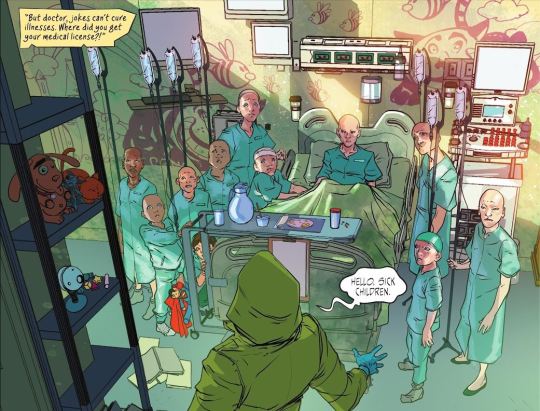
Joker's already killed the doctor who helped him, so I’m not gonna lie, I’m a tad concerned about where this is going.
But let's take a brief moment for Jason deciding this cop car will make the ideal distraction.
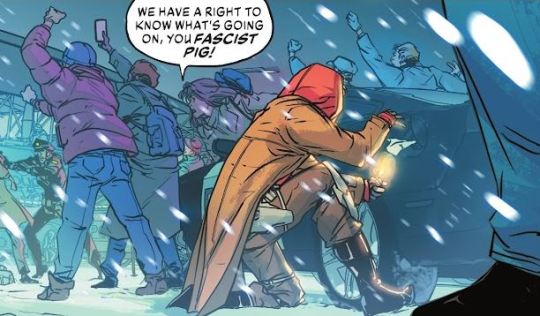
I really need to read more with Jason.
Anyway, my concerns about the kids soften when Joker is just disturbingly endearing toward them:
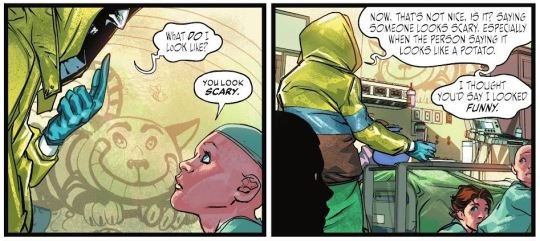
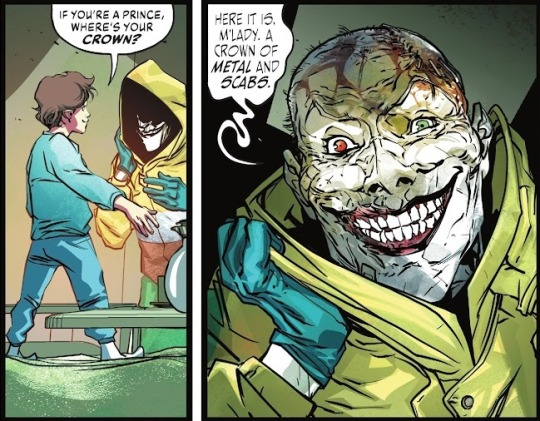
The kids, who all have terminal illnesses, are all too young to recognize Joker, or maybe it's more that the adults around them are unlikely to bring him up.
Their reaction to his humor is, uh, mixed.
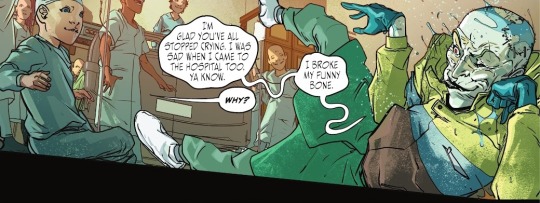
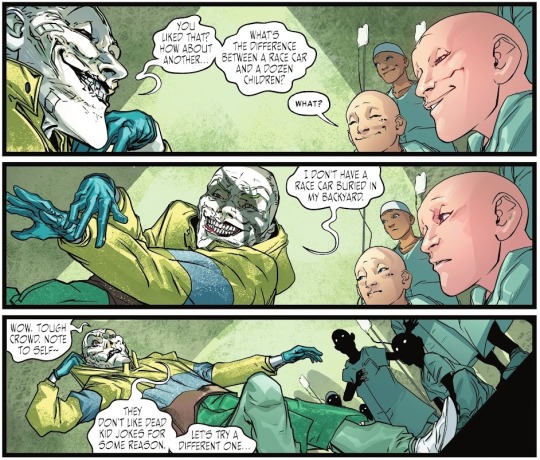
But he does good shadow puppets!
And then there's a wallbreak moment, where Joker references the different backer stories that we've seen so far (including this issue's).
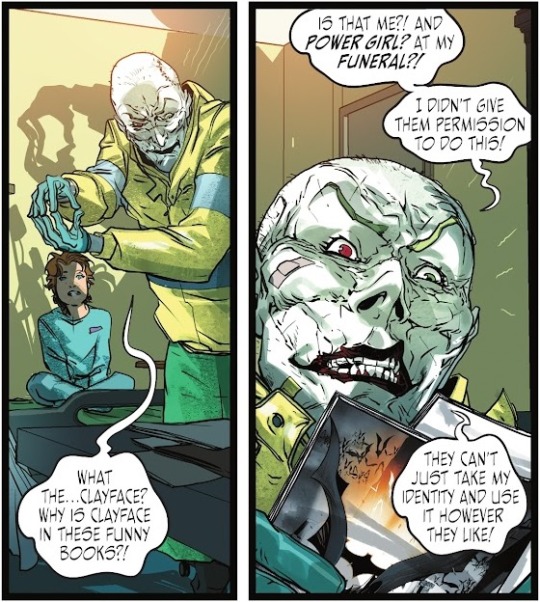
Except that's not what the kids are reading.
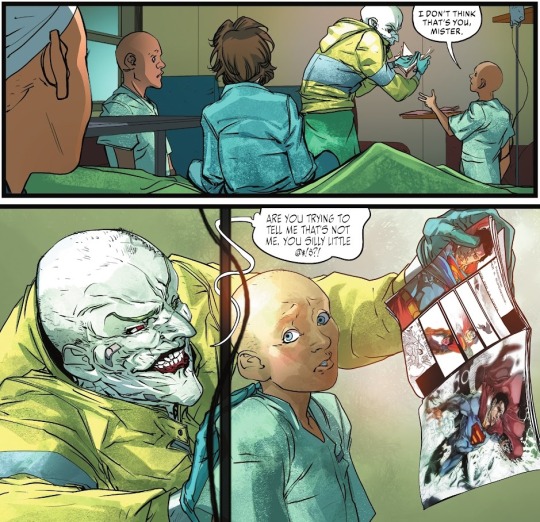
Makes me wonder if this is just getting back to classic Joker breaking the fourth wall, or if the backer stories all come from Joker’s mind...
Anyway, the kids like him enough that they don't snitch when a cop shows up.
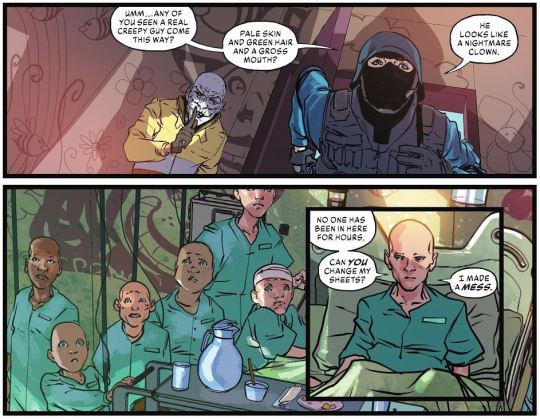
And unlike the poor doctor last issue, Joker leaves the kids as safe as he found them, with bonus advice!
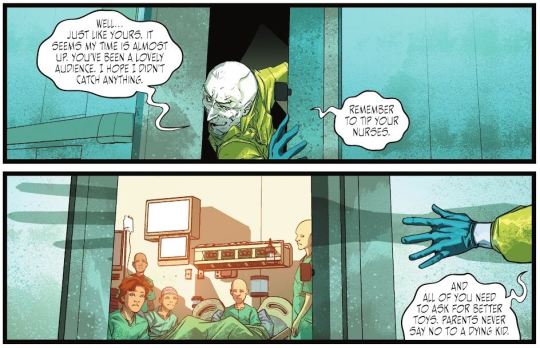
I mean, he kills a cop soon after for a disguise, but it's more interesting when Joker isn't, you know, indiscriminately murdering absolutely everyone he comes across, because he's just that cRaZy to think murder’s all jokes, oh ho ho.
Anyway, finally, Joker can escape!
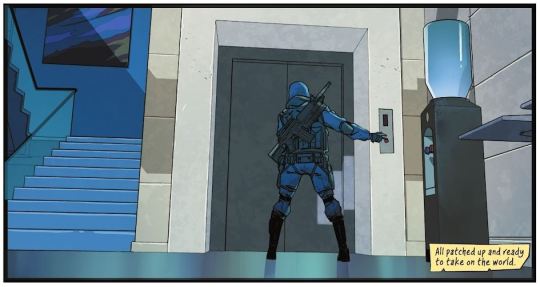
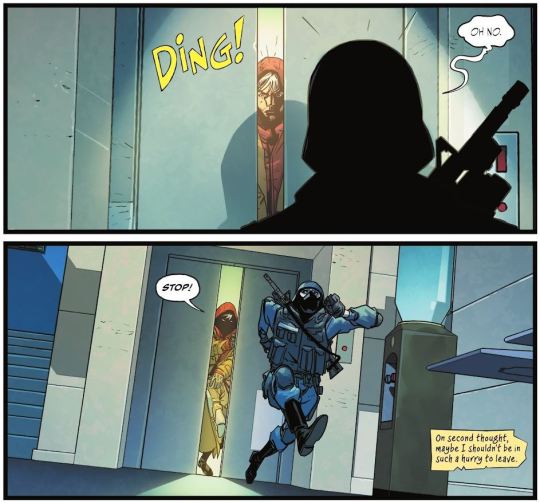
This made me lol
Joker does the "put down your gun or I'll kill the hostages" thing so he can lock everyone in a closet, during which he establishes that he believes he's the original Joker (BUT IS HE, ROSENBERG?).

And calls Jason out for stealing his old moniker. lol But once again, Joker does not kill people he could easily kill.

I'm not going to linger on if Joker actually has a plan for Jason. I'm going to linger on what happens right before Joker escapes. He ducks into the room of an old woman.

And he keeps talking to her like this for a few more panels. You're waiting for some kind of joke. Then the police break in and we see:

She's dead, but there's an unexpected implication that before he escaped, Joker helped her pass on, even giving her the photo of her and her late husband. There's a lot to unpack there!
And then we have the B-story. You know. So far in this run I feel like I get what the B-stories are getting at. This one... less so!
Joker is in a confrontation with Zatanna, another setup where he's trying to woo the female lead and she is just not having it.
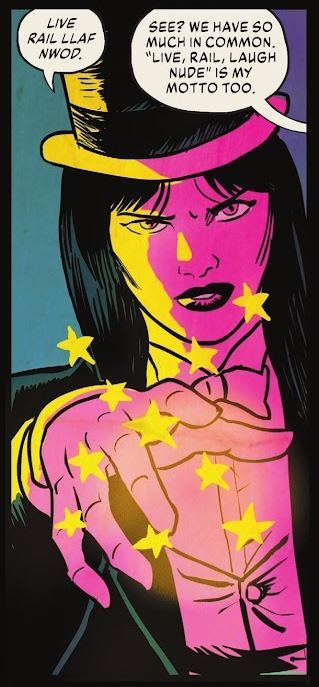
This made me laugh because I know how I interpret "rail" for Joker. Heyooooo
I enjoyed the third palindrome here too.
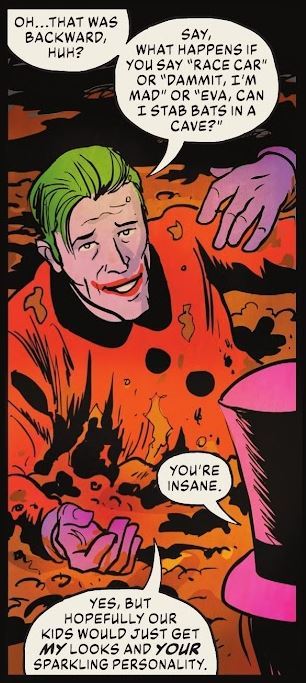
Zatanna is not interested in a family, and puts this spell on Joker.

"No one else will ever have your baby!"
And since this is the wacky story, the magic interprets that as Joker being the only one to have his baby.
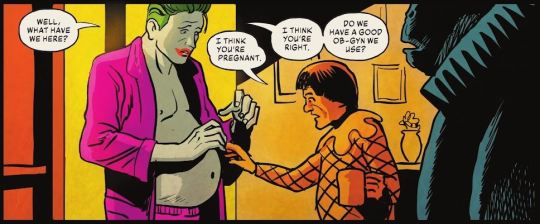
Joker finally sees a DC doctor, Doctor Phosphorus, and there's another gag about distinguishing between DC characters when we find that Joker apparently swallowed way too much mud during the fight.
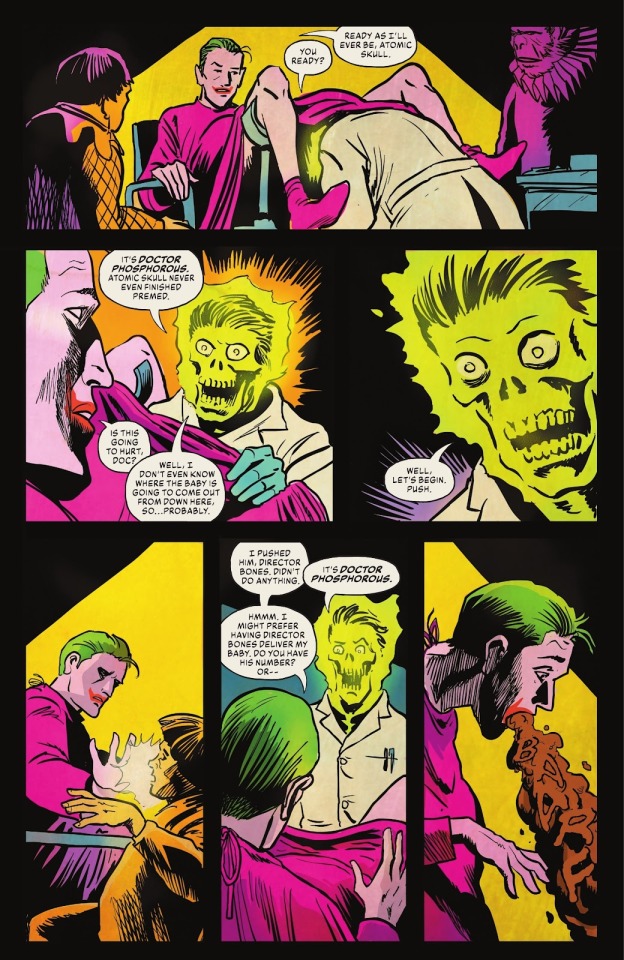
Joker asks for someone to kill the mudbaby. I'm not sure if it's supposed to actually be Clayface or just like Clayface, but again I think the main story meta moment is referring to this.
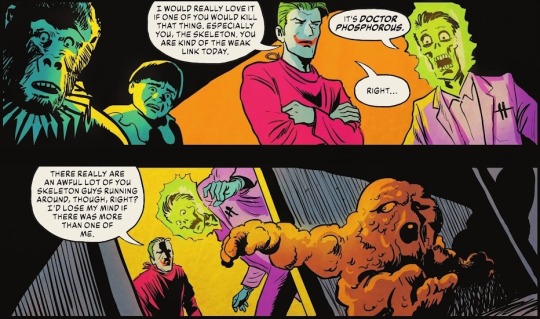
But then he changes his mind when the mudbaby turns into a little clone of himself, which he then brings back to Zatanna.

(This is giving me flashbacks to a terrifying Stephen Colbert magazine picture.)
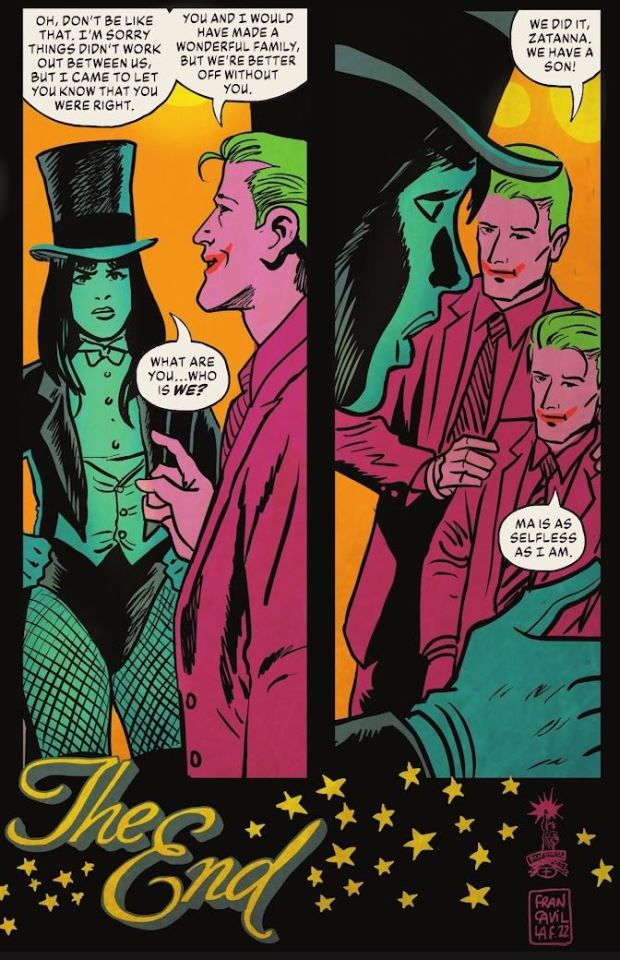
And so... yeah, I am not sure how to interpret this one, especially given how Joker even in this story itself is not fond of clones, though we did just see him as kind of kid-neutral in the main story. He's always been narcissistic, though, and that follows through here. Hmmm... Maybe future stories will shed more light on this one for me.
82 notes
·
View notes
Text
Good Stuff: Pixar’s Soul
SPOILERS AHEAD

Reviewing animation is a passion of mine; you probably know that if you’ve followed me long enough. I enjoy doing it for everything new that comes as much as the good stuff of yore. I can’t tell you why I got into it long as I have or if I should consider a full time gig of it, all I know it’s that it’s as much my passion as many other things in my life. That really is a piece to a personal puzzle I’ve developed as I watched Soul, this film from a studio that I admittedly wasn’t sure if it could get its groove back after it felt like they were stumbling a bit. The SparkShorts are good, but Incredibles 2, Toy Story 4, and Onward especially didn’t resonate with me. Didn’t tell me Pixar stood out as much as they in the “Golden Era”. This one did, and let me say it kinda cut deep.

Off the bat, as I understand that the trailers were quite a turn-off, I came to know before watching this that they weren’t trying to reveal everything. Honestly, the trailers were purposefully misleading as the most of what we got from the “Inside Out Knock-Off Blue Blob” world was a little over the first twenty minutes and the very, very end for the climax, less than you’d believe. It is the point I wasn’t too invested in with how simple it all felt; it’s basically if Microsoft or Google developed your birthright. It luckily doesn’t blow smoke up the ass with the way it runs things, takes more shots at ethical philosophy than any religion I could think of, but there’s good reason why we’re not in this world for very long. The Soul world did it’s purpose, but a little too well because it really wasn’t interesting outside the bond between Joe and 22 and a few laughs. Like I said though, we aren’t in it too long before we jump back to Earth with something I should’ve expected with this film but was still blown aback. I’m talking BODY SWAPPED ADVENTURE, Baby! [[SPOILERS AHEAD]]

Far Enjoyable than Your Name, don’t at me
A good chunk of the film has 22 in Joe’s body, Joe in a therapeutic cat’s body, and I’m surprised at how much engaging it was. It helps that 22 is never by any means a nuisance and they actually pull off the mechanics behind the trope well where it doesn’t feel like 22 in Joe’s body is annoyingly all over the place once she gets used to it. Weird that all of New York didn’t seem to give a shit about a middle-aged man stumbling in nothing but a medic robe, but never crossed that line for me to say, “Okay, this shit is stupid.” But what really makes this, basically the majority of Soul work, is Joe (or 22) interacting with the city.
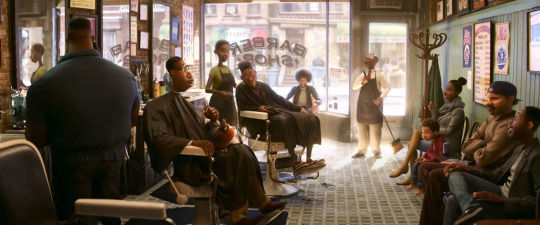
If there’s one great takaway for this, it’s indeed the musicality for the New York life. The barbershop, the subway, the jazz club, the tailor suite run by Joe’s mother, the living streets really make this city feel like a character in its own right. I say this film makes every person we meet count for something. The devil’s truly in the details; every location has a story to tell as well as remind viewers, myself especially, of people and places so close to life. The story paces along nicely too as we get to the “main event” before getting to the moment that made me cry the second time. I cried a total of four times, mostly in the latter half of the film because that was where things were certainly coming together. That was where, I doubt intentionally, the film hit me in the heart more than I could’ve imagined with the simple thought:

I was Joe and 22, and I still am from time to time
Sappy consideration, I know, but to get a little philosophical & personal for a bit. This film is generally about the direction of your life. Joe had a direction set in stone for himself to play the hottest jazz gig despite professedly doing/trying nothing else big with his life, living actively average you’d say. 22, the number which can mean “coming and going” since it’s a palindrome, has no direction despite being capable of understanding everything. As of now, I may only be in my early twenties, but I’ve felt like I’ve been both these characters at the same time, like a eternally spinning coin. I can feel directionless, having no clue to who I really want to be, but I know there is passion in me somewhere that I myself haven’t figured out yet but push forward with every major choice I make. I have both felt like I’ve done nothing and can’t do anything in life despite making it this far. But if there’s anything this film showed me, it’s that it’s alright.

If there’s anything that I can say describes Pete Doctor’s direction with this and Inside Out, it’s that he makes the most basic and simple human truths feel necessary, welcoming, and especially otherworldly. With Inside Out saying “it’s good to be more emotive”, Soul tells me “it’s good to enjoy the simple things in life.” Not to say you should live average and accept it, nor is every big moment you have will/should impact you the same way or the way you wanted, but appreciate those moments where things just go your way for a change. Where you can just look at the world, take a deep breath, and just feel comfortable with yourself to live another day. This isn’t a particularly surprising message, but it works because it fulfills everything it built up. Who else but Joe on that day, finally getting what he wanted after so long, can feel empty from it as opposed to the moments where he got to enjoy those enjoyably average moments he didn’t think he’d get along the way? And who else but him could show 22 that living doesn’t mean having a purpose or having that purpose in your mind 24/7.��
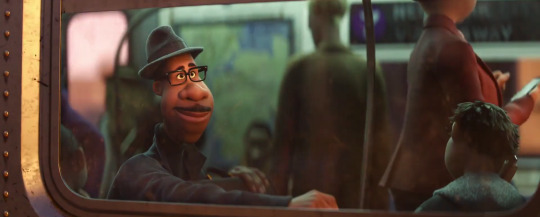
You can just... live as everything does.
This film isn’t as honest as Inside Out, especially with the whole concept of the Great Before, but it still offers that pragmatic advice in a way that definitely sticks. It can feel like this film came out at a bad time with the given circumstances of our reality, but it’s as much a simple pat on the back to tell you it’s okay. I figure the execution won’t be for everyone, the film isn’t perfect plotwise, but to me it’s definitely a golden, just as mature light for modern Pixar. A considerable classic that I hope is given well with time as much as a chance with all audiences.
4 Out of 5. A Soulful Sensation of a Film
#Soul#pixar soul#soul movie#pixar#disney#animation#cartoons#movies#analysis#reviews#long post#Good Stuff
1K notes
·
View notes
Text
reaffirming my ❤️ for മലയാളം
1. A Palindrome
Malayalam is perhaps the world’s only language that is a palindrome when written in English.
The word Malayalam is a combination of 2 words – ‘Mala’ meaning ‘mountain’ and ‘Alam’ meaning ‘region’. Thus the word literally means ‘the mountain region’.
The term originally refers to the land under the Chera dynasty. Later on, it became the name of the region’s language.
Until the 16th century, Malayalam, referred to by several other closely related names, including Malayanma and Malayalama.
2. A classical language with origins in Tamil
The popularly held opinion is that the Malayalam language evolved from Middle Tamil between the 9th and 13th centuries. Until then it was a western coastal dialect of Tamil.
However, there is also a contrary view that Malayalam did not originate from Tamil. Rather, both Malayalam and Tamil evolved from a common ancestor known as ‘Proto Tamil-Malayalam’.
‘Manipravalam’ was a macaronic language used in certain Malayalam language texts before it established its modern form in the 16th century. It was a combination of Tamil and Sanskrit.
The Manipravalam language and its script influence the modern form of the language greatly, so much so that Malayalam continues to be the one Dravidian language with extensive Sanskrit influence.
In 2013 Malayalam accorded the status of classical language by the Government of India.
3. Malayalam has some of the most complicated alphabets
Written in the Brahmic script, Malayalam has 15 vowels, 42 consonants, and certain other symbols. In fact, the language has some of the most specific and complicated sounds represented in letters. Equivalent differences hardly exist in other Indian languages.
There are 2 separate alphabets to denote the sound ‘r’- one for ‘r’ (ര) as in Spanish tres and the other for ‘ṟ’ (റ) as in Spanish Rojo. Equivalent pronunciation differences do not exist in English or Hindi.
Malayalam also has the alphabet ‘ഴ’(zha) which pronounced like the rhotic r as in ‘purse’ in English. This rhotic consonant is absent in almost all other Indian languages.
There are 2 separate consonants for the sound ‘l’ – one for ‘l’ (ല) as in ‘language’ and the other for ḷ (ള ) as in ‘plumber’.
4. Distinct nasal tones
Nasal sounds form an indispensable part of the spoken form of the Malayalam language.
The most basic pronoun ‘me’ is a nasal tone, pronounced as ‘ñaan’, where the ‘ña’ sounds like the NY in ‘canyon’. So is the nasal sound ‘ng’ as in ‘sing’ used extensively.
Several words that may have equivalent forms in other Indian languages like Hindi, take on a nasal tone in pronunciation in Malayalam.
For example in the Hindi word ‘Sundar’, the d sound distinctly pronounced in the NDA cluster.
However, in the equivalent Malayalam word ‘Sundaram’, the d sound becomes silent in the NDA cluster and instead pronounced as ‘sunnaram’, producing a distinct nasal tone in its place.
5. The Malayalam script was literally and figuratively ‘moulded’ for the printing press
The original Malayalam script that began as what is called the Vattelettu, has undergone significant changes. These changes made so as to accommodate the needs of making moulds for the printing press.
Until Benjamin Bailey, a British missionary brought the printing press to Kerala, Malayalam was written and printed in the Grantha script with square type fonts.
In 1829, Bailey ushered in a momentous change in the history of Malayalam by replacing these with the round script that is used to date.
The script from Bailey underwent further changes as the needs of the press changed. Local newspapers like the Malayala Manorama have done significant changes in the script.
6. The European hand in Malayalam
Not just Benjamin Bailey, several Europeans have had a decisive role in the development of the modern form of Malayalam language.
The first book to have Malayalam script printed in it was the Hortus Malabaricus, written in Latin by Henrik Van Rheede, the Governor of Dutch Malabar in 1678.
First Malayalam book Sampkshepa Vedartham which came out in 1772 didn’t publish anywhere in India but in Rome!
The first dictionary in Malayalam compiled by German scholar Herman Gundert. He has also extensively written about and codified Malayalam grammar.
7. Malayalam was written in multiple scripts by different communities
Before the evolution of the modern script, different communities in Kerala adopted Malayalam into the script of their liturgical languages.
Arabi-Malayalam is a script still in limited use among the Muslim community of Kerala. It is a variant form of the Arabic script used to write Malayalam.
Suriyani Malayalam or Syriac Malayalam was a script in popular use among the Saint Thomas Christians of Kerala, also known as the Nasranis. Malayalam, adopted into the Syriac alphabet with certain additional orthographic changes.
8. Distinct Dialects
Though not as many dialects as other Dravidian languages like Tamil, significant variations exist in spoken Malayalam.
The Dravidian encyclopedia enlists regional dialects of Malayalam into 13 dialect areas.
Caste and communal dialects are visible in Malayalam. The spoken form of Malayalam among the Mappila Muslims of Kerala has considerable influence on Arabic and Persian. Portuguese, Greek, and Syriac words find their way into certain dialects spoken by Christian communities.
While Hebrew, Syriac, and Ladino were dominant in Judeo Malayalam- a dialect spoken by the Cochin Jews who are virtually non-existent now in Kerala.
Jeseri and Byaare are 2 dialects of Malayalam that are extremely divergent from the Malayalam spoken in mainland Kerala.
While Jeseri is spoken in Lakshadweep, Byaare is spoken in Northern Kerala and Southern Karnataka.
9. A plethora of Loan Words
Malayalam is heavily influenced by several other languages that it consists of too many loan words.
These loan words that have come from languages like Portuguese, Dutch, and Arabichave become so ingrained into the everyday usage of Malayalam.
Common words in Malayalam for chair (kasera), table (mesha), pen (pena), paper (kadalas) and window (janala) all come from the Portuguese words cadeira, mesa, pena, cartez, and Janela respectively.
Malayalam has also given loanwords to Portuguese. The Portuguese words for jackfruit (jaca), teak (teca), and jaggery (jagra) have its origins in the Malayalam words chakka, thekku, and chakkara respectively.
In fact, the very word for toilet in Malayalam, ‘kakkoos’ comes from the Dutch ‘kakhuis’!
Arabic and Persian influences also abound in the language.
10. ‘New Gen’ slang words
Thanks to Malayali youngsters, the language now has a repository of ‘new gen’ words. These are existing Malayalam words that have taken on completely new meanings and connotations according to the changing times.
Social media and movies have boosted the popularity of these new words.
‘Thallu’ which originally means ‘to push’ is one of the most popular ‘new-gen’ slang. Thallu now refers to any statement that comes off as boasting.
‘Theppu’ is another latest addition which means ‘to ditch’ a lover. However, the word originally means ‘to iron something’.
‘Pani Kitti’ is a phrase that popularly meant ‘got a job’ until a few years back. But now it means that you’ve landed up in trouble!
The Malayalam language is as interesting and versatile as Kerala. Cultural transactions with a plethora of communities from across the world have shaped the language.
In a constant state of evolution, the next time you explore the language, Malayalam will have added a whole new set of quirky facts to itself!
41 notes
·
View notes
Text
So late last night, I found this newspaper clipping about Charles Thomson that was dated November 29, 1924 (aka Tommy’s 195 birthday) and I’m going to be “fact checking” if I guess??? I’ll be looking through it to find the things that aren’t true/might have changed as we find more stuff about him

That’s the full clipping, I will take the select parts out

So this one is kinda close, I have seen his mother’s death year to be 1740, but I have seen it much more frequently as being 1739

Older brother came before them = ✅
Older brother introduced him to Dr. Alison = ❌
His older brother (I think his name was William but I don’t remember off the top of my head), did help the family and really helped Tommy pay for his education (which Tommy was grateful for and he eventually payed his brother back in the form of a large plot of land). However, the person who got Tommy into Dr. Alison’s school was the mysterious lady whose name and true identity is unknown

All of these are technically correct, however the order is out of place. Tommy first taught at the Academy of Philadelphia (now the University of Pennsylvania) in their Latin School because Dr. Alison, whom he was close with, had just received a position there. I believe, that this is when Tommy met Benjamin Franklin. Tommy was now in Philadelphia full time and Franklin was the creator of the school. Tommy saw Franklin as a mentor and they formed a close relationship. After he left the University of Philadelphia, he went to work at the Friends’ school and also taught classical studies to a class of about 34 boys.

There’s nothing wrong with this other than that “Hannah” has an H at the end (it’s a palindrome)

This might be 100% factual, but I have never seen it anywhere else so I doubt it

He spent about 19 years in total on his Bible. They were probably referring to a quote that we have from Tommy that said, “It [the translation of the Bible] has occupied my closest attention and been my constant and employment for more than twelve years.” However, Tommy wrote that on January 6, 1801, there was still another 7 years to go before it was finally printed.
4 notes
·
View notes
Text
Which One of These Three Time-Traveling Films is the Best?

Written by Rayhan Abrar Rizkan
Writing this comparing and contrast piece has been a challenge for me, the biggest challenge is to pick what topics do I really want to discuss. The runner ups are : Star Wars, the Ocean’s franchise, and even down to which is the best girl in Chainsaw Man. Other references aside, this one is my pick, due to my fascination towards Time-Traveling films. For this piece, I narrowed down the nominations into these three : TENET, Avengers: Endgame, and Terminator 2: Judgment Day.
I picked TENET because of my personal bias. I picked Avengers: Endgame because you all have probably seen it. And I picked the second Terminator movie because it is one of the most quintessential, monumental, and an absolute classic to set the pop culture we know today. I could have picked Back to the Future, but I can’t, or won’t, pick one. Let us begin with the first point of comparison : The Story.
The most important thing to a film is the script, the writing that you sell to the studio or anyone you want to work with. It goes without saying, it has to be good. A Movie has to tell a story, to follow a character, and/or to set a specific goal in mind. It is the easiest and the first thing people say when they are describing a movie, for example, “It’s the one where they have to carry a ring to the volcano.”, “There’s wizards, magic, and they have to defeat a snub-nosed villain.”, “So there’s this guy, and he got bit by a radioactive spider....”. Case in point, you can probably guess those movies just by the plot or the premise, that is set by the script, that is how powerful a story could be if written properly.
TENET has a simple story. Calling it complicated is an understatement, but if you finally opened your third eye somehow while watching this movie, it is simple. TENET is a lot of movies stacked into one, it is a spy movie, a heist movie, a sci-fi, and action. TENET follows the Protagonist (That is how you know this movie is beyond awesome, they do not even bother naming the lead) to find pieces of an advanced weapon algorithm with secret battles coming from the past and the future to stop World War III from the hand of the main villain, Sator. See my point here? It is simple..... but I did leave out the whole time-bending plot to see it all in one straight line. . But when you see all things unveil, especially during the second watch seeing that it is how Nolan makes his movies, you can truly appreciate TENET for what it is, cinema.
Avengers: Endgame, you already know the story. After their massive defeat in Infinity War, the original members with the help of few others tries to undo what Thanos did and return those who are lost. This movie is plain and vanilla yet the perfect closing for this symphony of Marvel’s ensemble cast in comic book movies, you do not have to follow all 21 MCU movies to watch the adventures that they went through to understand the main story, but they will reward you if you do, as there are tons of fan service and easter eggs to get excited for.
For Terminator 2, maybe I should explain on why I chose this instead of the original, and it ties in to the story. In the first Terminator movie, Skynet, to put it simply is a future-evil-internet-robot-brain programmed to eradicate humanity and enslave those who survived in the purge. Skynet sent a robot assassin with the face of Arnold Schwarzenegger to kill Sarah Connor from giving birth to John Connor, the future leader of the resistance that will defeat Skynet. So the John Connor in the future sent Kyle Reese, one of the member of the resistance to protect his mother Sarah from the Terminator Model 101. Kyle eventually stopped the Terminator and somehow fathered John Connor in the process. To recap the first movie, John sent his own father to protect his mom from the past. Now, the second movie is where they did a twist. Instead of just having another advanced Terminator to the past sent by another version of Skynet, the resistance also sent another reprogrammed Terminator to protect the target that is (kid) John Connor. If this is done now, the twist is completely overdone and seen as nothing but a gimmick. But for a movie in the 90’s? this is revolutionary. Its like having Jason Krueger as your ally in the sequel, but replace that with an Arnold Schwarzenegger looking killer robot despite the lack of his trademark of making unintelligible noises. Because of the same face, the Terminator has to convince Sarah that he is not the Terminator she once knew in the first movie, but a reprogrammed one set to protect them, this interaction of not trusting one another and always be on guard sets up the movie very well. The flick is a staple of action movie back in the day, having two indestructible killing machines squaring up against one another, how can anyone top that at that era?
Now that we are all caught up with the story, it is time to discuss the soul of these movies have in common, the Time-traveling aspect, the main plot device, the cause or the breaker of movie retcons. In this short list, Terminator has to be the simplest in terms of the mechanics of the time-travel story. The time machine is one time use only, as it can only be used in the future where such things exist. So once you go back in time, the only way to go back to the future is to wait, just like everyone else. And what you did in the past will instantly affect the future accordingly. The time machine in Terminator movies has to be the one with the weirdest mechanic, where you can only send things with living tissues and no other, now that the fact is laid out on you then yes, everyone who went back in time has to be naked. So they have to find new clothing when they arrived. At least that is their explanation on why the Terminator has to be wrapped up in synthetic human skin, not to show off Arnold’s five hours a day of intensive muscle toning in six months with the help of a big pile chicken breast and a year supply of protein shake, not at all.
Avengers: Endgame has the most flexible machine out of all, where you can set the time and place of where you want to be, as long as you have enough supply of Pym particles to go subatomic and travel a safe passage through the fabric of time. But with multiple journeys with different groups you will run a risk of creating an alternate timeline, but they simply nullify such possibility with having Hulk said that they will go back in time after the final battle is done, and return the things they took in the past back to its place and time so nothing will inherently change. The time traveling part of the movie is the charm of Endgame, where we get to re-visit the characters, places, and events we have seen in the previous films in a different perspective that is canon to the universe.
Now, this is where it all gets tricky to explain, because the time-traveling of TENET is not the same as any other movies I have seen. Calling it a time-traveling is not even entirely accurate, but the mechanic of how it works calls for more of a “Time-inversion”. The time machine in this film is very rustic, where you go into this big turning door that leads to the other side of the room, but once you are “inverted”, you move forward in time, but the world around you goes backwards. You cannot choose which time you want to go to, if you want to go back in time for 10 minutes, you have to wait it out while being inverted for 10 minutes, that is why the palindrome suits with the whole movie. This makes amazing visuals when combined with action sequences, imagine reverse car chases, bullets were caught to the gun instead of being shot out of, punches were pulled instead of thrown. In other words, if you see a sequence of two people with one of them inverted, they can both win or lose at the end depending on which point-of-view you choose.
The time inversion in TENET is not only treated as a plot device, but also the philosophy that is abided by the movie, as there is only one timeline that exist in the movie. This is made clear in the story that no matter what you do, you cannot change the outcome of the future, as the present is set with the human’s free will, and even though they are randomly generated, it happened anyway. “What’s happened, happened” said Neil, one of the main characters in the movie explaining how time inversion works to the Protagonist. It is not a battle to change the outcome, but to gain a perspective for what’s to come. Whatever happens, happened and will happen all at the same time. With the limited mechanic of time-inversion that TENET has (or had, or will have, this is confusing even to me now), it is amazing what it can achieve in terms of storytelling, how the story we see in front of us is one enormous temporal pincer collision of the past, future, and present in one sitting (or collide, collided, will collide, I do not know what is happening). From my standpoint, clearly I prefer TENET above all else, but do let me know what’s your pick out of these three! Better yet, what is your favourite time-traveling film?
#time travel#time inversion#review#tenet#avengers#avengers endgame#christopher nolan#terminator#terminator 2#arnold schwarzenegger#tumblr#robert pattinson tenet#tenet memes#movies#movie review#film#film review#cinema#marvel#mcu#comics#marvel comics#marvel movies#tony stark#iron man#the protagonist#t800
4 notes
·
View notes
Note
Cassandra Cain and Zatanna Zatara for the character ask thing
I’ve got another ask waiting JUST for Cass so I’ll save her for later! (& again y’all if ya wanna send in more characters plz send them individually thanks!)
Favorite thing:
How grounded she is. With every fantastical adventure and magical obstacle she faces, no matter how much it turns her entire world around, she’s still engaging with the Normal™️ world and approaches from that mindset when she can. She knows she’s a bridge between mortals and magic and she’s perfectly content and takes pride in that job.
Least favorite thing:
Bc of this she tends to be DC/fandoms go-to magic user. Guys there’s at least TEN others y’all can use too. She’s the most well-known but Zee is a BUSY lady thanks. The burden of being A bridge doesn’t mean that she’s the ONLY one.
Favorite line:
“OGRE FLOG A GOLFER GO!” (It’s a palindrome ok? Ya just GOTTA READ THAT ISSUE)
Friend-Ships:
Ima list DinahZee later too, but that’s bc I love BOTH their friendship+romance. Uhh, otherwise LOVE how she’s kinda started building a rapport with Kirk & Bobo in JLD, and just when she makes friends with Magic users in gen? LOVE LOVE LOVE the banter she has with her Crew too
Romantic-Ships:
Magicblazer, DianaZee, DinahZee, Covenshipping 2.0, Batanna, IvyZee, Catanna, NightmareMagic, Zee13 but only bc I like that being a Consistent Part of her History and also a Regret™️ lmaooooooo oh WAIT AND MIKEYZEE. That’s StageMagic hahaha
Don’t Ship at all much anymore:
Can’t think of any off the top of my head, other than Chalant sometimes making me Grumpy. But that’s bc WhYJ in general makes me Grumpy for what they did to Zee lmao
Random Headcanon:
Absolutely gives impromptu street shows on her days off. But she has a self-imposed rule to ONLY use sleight-of-hand for those moments. It’s how she puts in Practice when she’s trying out new, close-up tricks. Also some-what related: if she’s setting up a Three Card Monte op for the day, she tries to suss out marks that give Vibes. Whether those Vibes are Good or Bad will determine how the game goes for them lmao
Unpopular Opinion:
Zee COULD be OP, but anyone who says that she’s OP unironically doesn’t understand her. Magic takes a toll on her just like it does anyone else. She’s not an endless magic battery that can just keep speaking the universe into inverting itself forever. She can do a lot of impossible things, but that doesn’t mean she can make it stick forever. Or that she wants to make it stick.
Song I Associate with them:
Currently? Stevie Nicks’ “Rooms On Fire” Generally I associate Stevie+Fleetwood with Zee & most magic users already but this ones really HITTIN it for me for Zee today
Fav pic of them:

The variant cover for Zatanna #3 (by Brian Bolland) is one of the BEST pics of Zee. Just such a Classic™️ Celeb Look. Altho it’s TIED with her outfit+how she carries herself at the end of Zatanna #7 but I don’t wanna stretch this post any further lmao
#zatanna zatara#asked and answered#anonymous asks#ask meme#okay. internet is wonky today at the house so ill try to answer some more later tonight 👍👍👍
19 notes
·
View notes
Text
Dust Volume 6, Number 12

The Flat Five
It’s November, and the culture is telling us to be thankful again, at least from a distance. We’re a prickly, argumentative bunch here at Dusted, but I think we can all agree on gratitude for our health, each other and the music, good and bad, that comes flooding in from all sides. So while we may not agree on whether the best genre is free jazz or acid folk or vintage punk or the most virulent form of death metal, we do concur that the world would be very dull without any of it. And thus, seasonably overstuffed, but with music, we opine on a number of the best of them once again. Contributors this time include Bill Meyer, Andrew Forell, Tim Clarke, Ray Garraty, Jennifer Kelly, Mason Jones, Patrick Masterson, Jonathan Shaw and Justin Cober-Lake. Happy thanksgiving.
Cristián Alvear / Burkhard Stangl — Pequeños Fragmentos De Una Música Discreta (Insub)
Pequeños fragmentos de una música discreta by CRISTIÁN ALVEAR & BURKHARD STANGL
The acoustic guitar creates instant common ground. Put together two people with guitars in their hands together, and they can potentially communicate without knowing a word of each other’s language. They might trade blues licks, verses of “Redemption Song,” or differently dire remembrances of “Hotel California,” but they’re bound to find some sort of common language. This album documents another chapter in the eternal search. Cristián Alvear is a Chilean classical guitarist who has found a niche interpreting modern, and often experimental repertoire. Burkhard Stangl is an Austrian who has spent time playing jazz with Franz Koglmann, covering Prince with Christoph Kurzmann and realizing compositions that use the language of free improvisation with Polwechsel. This CD collects eight “Small Fragments Of Discreet Music” which they improvised in the course of figuring out what they could play together. Given their backgrounds, dissonance is part of the shared language, but thanks to the instrumentation, nothing gets too loud. Sometimes they explore shared material, such as the gentle drizzle of harmonics on “No5.” Other times, they find productive contrasts, such as the blurry slide vs. palindromic melody on “No6.” And just once, they flip on the radio and wax melancholic while the static sputters. Sometimes small, shared moments are all you need.
Bill Meyer
Badge Époque Ensemble — Self Help (Telephone Explosion Records)
Self Help by Badge Époque Ensemble
Toronto collective Badge Époque Ensemble display the tastefully virtuosic skill of a particular strain of soul-inflected jazz-fusion that politely nudged its way into the charts during the 1970s. Led by Max Turnbull (the erstwhile Slim Twig) on Fender Rhodes, clavinet and synthesizers with members of US Girls, Andy Shauf’s live band and a roster of guest vocalists, Badge Époque Ensemble faithfully resurrect the sophisticated sounds of Blue Nun fuelled fondue parties and stoned summer afternoons by the pool. Meg Remy and Dorothea Paas share vocals on “Sing A Silent Gospel” which is garlanded with Karen Ng’s alto saxophone and an airy solo from guitarist Chris Bezant; it’s a track that threatens to take off but never quite does. The strength of James Baley’s voice lifts the light as air psych-funk of “Unity (It’s Up To You)” and Jennifer Castle does the same for “Just Space For Light” during which Alia O’Brien makes the case for jazz flute — Mann rather than Dolphy — with an impressive solo. The most interesting track here is the 11 minute “Birds Fly Through Ancient Ruins” a broodingly introspective piece which allows Bezant, Ng and bassist Giosuè Rosati to shine. Self-Help is immaculately played and has some very good moments but can’t quite get loose enough to convince.
Andrew Forell
Better Person — Something to Lose (Arbutus)
Something to Lose by Better Person
Like any musical genre, synth-pop can go desperately awry in the wrong hands. The resurgence of all things 1980s has been such a prevalent musical trend in recent years that it takes a deft touch to create something that taps into the retro vibe without coming across as smug. Under his Better Person moniker, Berlin-based Polish artist Adam Byczyowski manages to summon the melancholy vibe of 1980s classics such as “Last Christmas” by Wham!, “Take My Breath Away” by Berlin, and “Drive” by The Cars, reimagined for the 21st century and set in a run-down karaoke bar. This succinct and elegant half-hour set pivots around atmospheric instrumental “Glendale Evening” and features three Polish-language tracks — “Na Zawsze” (“Forever”), “Dotknij Mnie” (“Touch Me”), and “Ostatni Raz” (“Last Time”) — that emphasize the feel of cruising solo through another country and tuning into a unfamiliar radio station. There’s roto-toms, glassy synth tones, suitably melodramatic song titles (including “Hearts on Fire,” “True Love,” and “Bring Me To Tears”), plus Byczyowski’s disaffected croon. It all creates something unexpectedly moving.
Tim Clarke
Big Eyes Family — The Disappointed Chair (Sonido Polifonico)
The Disappointed Chair by Big Eyes Family
Sheffield’s Big Eyes Family (formerly The Big Eyes Family Players) released the rather fine Oh! on Home Assembly Music in 2016. Its eerie blend of folk and psych-pop brought to mind early Broadcast, circa Work and Non Work, before Trish Keenan and James Cargill started to explore more experimental timbres and themes of the occult. Bar perhaps the haunted music box instrumental “Witch Pricker’s Dream,” Oh!’s songs cleaved along a similar grain: minor keys, chiming arpeggiated guitar, spooky organ, in-the-pocket rhythm section, plus Heather Ditch’s vocal weaving around the music like smoke. The Disappointed Chair is much the same, enlivened with a touch more light and shade, from succinct waltz “(Sing Me Your) Saddest Song,” to the elegant Mellotron and tom-toms of “For Grace.” “From the Corner of My Eye” is stripped right back, with an especially affecting guitar line, plus Ditch’s vocals doubled, with the same words spoken and sung, like a voice of conscience nagging at the edge of the frame. It’s a strong set of songs, only let down by the boxy snare sound on “Blue Light,” and on “The Conjurer,” Ditch’s lower register isn’t nearly as strident as her upper range.
Tim Clarke
Bounaly — Music For WhatsApp 10 (Sahel Sounds)
Music from Saharan WhatsApp 10 by Bounaly
The tenth installment in Sahel Sounds’ Music For WhatsApp series introduces another name worth remembering. In case your attention hasn’t been solely faced on the ephemeral charms of contemporary Northwest African music in 2020, here’s the scoop: Each month, Sahel sounds uploads a brief recording that a musician from that corner of the world recorded on their cell phone and delivered via the titular app, which is the current mode of music transmission in that neck of the woods. At the end of the month they take it down, and that’s that. This edition was posted on November 11, so set your watch accordingly. Bounaly is originally from Niafounké, which was the home of the late, great Ali Farka Touré. Since civil war and outside intervention have rendered the city unsafe for musicians of any speed, he now works in Mali’s capital city, Bamako, but his music is rooted in the bluesy guitar style that Touré championed. Accompanied solely by a calabash player and surrounded by street sounds, Bounaly’s singing closely shadows his picking, which is expressive without resorting to the amped-up shredding of contemporary guitarists like Mdou Moctar.
Bill Meyer
Cash Click Boog — Voice of the Struggle (CMC-CMC)
youtube
Last year, Cash Click Boog made a few very noticeable appearances on other people albums (especially on Lonnie Bands’ “Shred 1.5” and Rockin Rolla’s First Quarter) but his own Extras was a minor effort. This Californian rapper was always a dilettante at music, but that was his main appeal and ineradicable feature: you always knew that he’s always caught up in some very dark street business, and he appears in a booth once every blue moon, almost by accident. He is that sort of a player who always on the bleachers, yet when they let him on the field he always does a triple double or a hat trick (depending on a kind of sport).
Voice of the Struggle was supposed to be his big break, the album in which he would expend his gift for rapping while remaining in strictly amateurish frame. Sadly, Boog has chosen another route, namely going pop. He discards his amateur garbs almost completely and auto-tunes every track. If earlier he was too dark even by street standards, now almost all the tracks could be safely played on a radio. The first eight songs are more or less pop-ish ballads about homies in prison, tough life and the ghetto. By the time we reach the last three tracks where Boog recovers his old persona, it’s already too late. The struggle remains but the voice is gone.
Ray Garraty
The Flat Five — Another World (Pravda)
youtube
The Flat Five musters a great deal of Chicago musical fire power. Alt.country chanteuse Kelly Hogan, Andrew Bird collaborator Nora O’Connor and Casey McDonough sing in Andrews Sisters harmonies, while NRBQ mainstay Scott Ligon minds the store and Green Mill regular Alex Hall keeps the rhythm steady. The sound is retro —1930s radio retro — but the songs, written by Ligon’s older brother Chris, upend mid-century American pieties with sharp, insurgent wit. A variety of old-time-y styles are referenced — big band jazz, country, doo wop and pre-modern pop — in clean, winking style. Countrified, “The Great State of Texas” seems, at first, to be a fairly sentimental goodbye-to-all-that song, until it ends with the revelation that the narrator is on death row. “Girl of Virginia,” unspools a series of intricate, Cole Porter-ish rhymes, while waltzing carelessly across the floor. The writing is sharp, the playing uniformly excellent and the vocals extra special, layered in buzzing harmonies and counterpoints. No matter how complicated the vocal arrangements, no one is ever flat in Flat Five.
Jennifer Kelly
Sam Gendel — DRM (Nonesuch)
youtube
Normally, Sam Gendel plays saxophone in a classic jazz style. You might have caught him blowing dreamy, airy accompaniments on Sam Amidon’s last record, for instance, or putting his own spin on jazz standards in the solo Satin Doll. But for this album, Gendel experimented with ancient high tech — an Electro Harmonix DRM32 drum machine, some synthesizers, a 60-year-old nylon-string guitar —t o create hallucinatory fragments of beat-box-y, jazz-y sound, pitched somewhere between arty hip hop and KOMPAKT-style experimental electronics. “Dollars,” for instance, laces melancholy, Latin-flavored guitar and crooning with vintage video-game blips and bleeps, like a bossa nova heard dimly in a gaming arcade. “SOTD” dances uneasily in a syncopated way, staccato guitar runs paced by hand-claps, stuttered a-verbal mouth sounds and bright melodic bursts of synthesizer. “Times Like This” poses the difficult question of exactly what time we’re in—it has the moody smoulder of old soul, the antic ping and pop of lush early 00s electronics, the disembodied alien suavity of pitch-shifted R&B right now. The ringer in the collection is a cover of L’il Nas’ “Old Town Road,” interpreted in soft Teutonic electro tones, like Cluster at the rodeo. It’s odd and lovely and hard to get a bead on, which is pretty much the verdict for DRM as a whole.
Jennifer Kelly
Kraig Grady — Monument of Diamonds (Another Timbre)
MONUMENT OF DIAMONDS by Kraig Grady
The painting adorning the sleeve of Monument of Diamonds is entitled Doppler Effect in Blue, and rarely has the cover art’s name so accurately described the sound of the music paired with it. The album-length composition, which is scored for brass, saxophones and organs, consists almost entirely of long tones that Doppler in slow motion, with one starting up just before another peters out. The composer, Kraig Grady, is an Australian-based American who used to release albums that purported to be the folk music of a mythical land called Anaphoria. Nowadays he has no need for such subterfuge, since this lovely album holds up quite well on its own merits. Inspired by Harry Partch and non-Western classical music systems, Grady uses invented instruments and strategically selected pitch intervals to create microtonal music that sounds subtly alien, but never harsh on the ears. As the sounds glide by, they instigate a state of relaxed alertness that’ll do your blood pressure some good without exposing you to unnecessary sweetener.
Bill Meyer
MJ Guider — Sour Cherry Bell (Kranky)
Sour Cherry Bell by MJ Guider
MJ Guider’s second full length is diaphanous and monolithic, its monster beats sheathed in transparent washes of hiss and roar. “The Steelyard” shakes the floor with its pummelling industrial rhythms, yet shrouds Guider’s spoken word chants with surprising delicacy. “Body Optics” growls and simmers in woozy synth-driven discontent, while the singer lofts dreamy melodic phrases over the roar. There’s heft in the low-end of these roiling songs, in the churn of bass-like synthetics, the stomp of computer driven percussion, yet a disembodied lightness in the vocals, which float in pristine purity over the roar. Late in the disc, Guider ventures a surprisingly unconfrontational bit of dream pop in “Perfect Interference,” sounding poised and controlled and rather lovely at the center of chiming, enveloping synthetic riffs. Yet the murk and roar makes her work even more captivating, a glimpse of the spiritual in the midst of very physical wreck and tumult.
Jennifer Kelly
Hisato Higuchi — キ、Que、消えん? - Ki, Que, Kien? (Ghost Disc)
キ、Que、消えん? - Ki, Que, Kien? by Hisato Higuchi
Since 2003, Tokyo-based guitarist Hisato Higuchi has quietly released a series of equally-quiet albums, many on his own Ghost Disc label, which is appropriately named. Higuchi's work on this and the previous two albums of his "Disappearing Trilogy" is a sort of shimmering, melancholy guitar-and-vocal atmosphere — downer psych-folk in a drifting haze. His lyrics are more imagery than story, touching on overflowing light, winter cities, the quiet world, and the transience of memories. As the guitar floats slowly into the distance, Higuchi's voice, imbued with reverb, is calmly narcotic, like someone quietly sympathizing with a friend's troubles. These songs, while melancholy, convey a peacefulness that's a welcome counterbalance to the chaotic year in which we've been living. Like a cool wind on a warm summer evening, you can close your eyes and let Higuchi's music improve your mood.
Mason Jones
Internazionale — Wide Sea Prancer (At the Blue Parade) (Janushoved)
Wide Sea Prancer (At The Blue Parade) by Internazionale
It’s been nearly half a decade since Copenhagen’s Janushoved first appeared in these annals, and in that time, a little more information — and a lot more material — has cropped up to lend some context to the mystery. The focus, however, steadfastly remains with the music — perhaps my favorite of which among the regular projects featured is label head Mikkel Valentin’s own swirling solo synth vehicle Internazionale. In addition to a reissue of 2017’s The Pale and the Colourful (originally out on Posh Isolation), November saw the release of all-new songs with Wide Sea Prancer (At the Blue Parade), 14 tracks of gently abrasive headphone ambient that carry out this type of sound very well. Occasionally there is a piano (“Callista”) or what sounds like vocals (“El Topo”), but as it’s been from the start, this is primarily about tones and moods. Notes for the release say it’s a “continuation and completion of the narrative set by the release Sillage of the Blue Summer,” but it’s less the narrative you should be worried about missing out on than the warmth of your insides after an uninterrupted listen.
Patrick Masterson
Iress — Flaw (Iress)
Flaw by Iress
Sweeping, epic post-metal from this LA four piece makes a place for melodic beauty amid the heaviness. Like Pelican and Red Sparrows, Iress blares a wall of overwhelming guitar sound. Together Michelle Malley and Alex Moreno roust up waves and walls of pummeling tone as in opener “Shame.” But Iress is also pretty good at pulling back and revealing the acoustic basis for these songs. “Hand Tremor” is downright tranquil, with wreathes of languid guitar strumming and Malley’s strong, gutsy soprano navigating the full dynamic range from whisper to scream. “Wolves” lumbers like a violent beast, even in its muscular surge, there’s a slow, anthemic chorus. Likewise, “Underneath” pounds and hammers (that’s Glenn Chu on drums), but leaves space for introspection and doubt. It’s rare that the vocals on music this heavy are so good or so female, but if you’ve liked Chelsea Wolfe’s recent forays into ritual metal, you should check out Iress as well.
Jennifer Kelly
Junta Cadre — Vietnam Forever (No Rent Records)
"Vietnam Forever" (NRR141) by Junta Cadre
Junta Cadre is one of several noise and power electronics projects created by Jackson Abdul-Salaam, musician and curator of the long-running Svn Okklt blog. As the project’s name implies, Junta Cadre has an agenda: the production of sound that seeks to thematize the ambiguities of 20th-century radical, revolutionary politics. The project’s initial releases investigated the Maoist revolution in China, and the subsequent Cultural Revolution of the late 1960s and 1970s. Vietnam Forever shifts topics, to the American War in Vietnam, and tactics, including contributions from other prominent harsh noise acts and artists: the Rita, Samuel Torres of Terror Cell Unit, Leo Brucho of Controlled Opposition and others. Given those names, Vietnam Forever is as challenging and rigorous as you might expect. Waves of dissonant, electronic hum and fuzz accumulate and oscillate, crunching and chopping into textured aural assaults; wince-inducing warbles and needling feedback occasionally assert themselves. Abdul-Salaam’s harsh shout cuts in and out of the mix. The tape (also available as a name-yo’-price DL on Bandcamp) presents as two side-long slabs of sound, both over seventeen minutes long, both completely exhausting. At one point, on Side A, Abdul-Salaam repeatedly shouts, “Beautiful Vietnam forever!” It’s hard to say what he means. An affirmation that Vietnam survived the war? That its people and culture endure? Or that the U.S. can’t seem to shake the war’s haunting presence? Or even a more worryingly nihilistic delight in the war’s carnage, so frequently aestheticized in films like Apocalypse Now (1979), Full Metal Jacket (1987) and Da Five Bloods (2020)? The noise provides no closure. Maybe necessarily so.
Jonathan Shaw
Bastien Keb — The Killing of Eugene Peeps (Gearbox)
youtube
The Killing of Eugene Peeps is a soundtrack to a movie that never was, a noir-ish flick which winds restlessly through urban landscapes and musical styles, from the orchestra tremors of its opening through the folky group-sing of “Lucky the Oldest Grave.” “Rabbit Hole” wafts by like an Elephant Six outtake, its woozy chorus lit by glockenspiel notes, while “God Bless Your Gutters” conjures jazzy desolation in piano and mordant spoken word. “All the Love in Your Heart” shimmers like a movie flashback, a mirage of blowsy back-up singing, guitar and muttered memories. “Street Clams” bristles with funk and swagger, an Ethio-jazz sortee through rain slicked streets. What’s it about? Musically or narratively? No idea. But it’s worth visiting these evocative soundscapes just for the atmosphere. It’s a film I’d like to see.
Jennifer Kelly
Jesse Kivel — Infinite Jess (New Feelings)
youtube
Nostalgia haunts the new solo album from Kisses guitarist/singer Jesse Kivel. Infinite Jess is full of that knowing melancholy of The Blue Nile, Prefab Sprout and The Pale Fountains that was so magnetic to a certain brand of sensitive young thing seeking to articulate their inchoate visions of a future steeped in romance and adventure. Think wistful mid-tempo songs wrapped in cocoons of strummed guitars, shuffling percussion and wurlitzer piano fashioned into a catalogue of adolescent radio memories. These tunes are topped by the understated sincerity of Kivel’s voice and lyrics which effectively evoke the place, time and emotion of his vignettes. The production suffers occasionally from a distracting reliance on too perfectly rendered tropes — overly polite drum programming, thumbed bass, blandly smooth electric piano — but the overall effect is oddly beguiling. Infinite Jess closes with a charmingly wobbly instrumental cover of Don McLean’s “Vincent” played on the wurlitzer that captures the poignancy of the melody and serves as a fitting epilog to the record.
Andrew Forell
Kyrios — Saturnal Chambers (Caligari Records)
Saturnal Chambers by KYRIOS
The corpsepaint-and-spiked-codpiece crowd are still making tons of records, but fewer and fewer of them are interesting or compelling. The retrograde theatrics and cheap pessimism can be irritating enough (I’d rather be reading Schopenhauer, thanks); it’s even more problematic when the songs can muster only the vividness and savor of stiff leftovers from the deep-freezer’s darkest and dankest corners. Still, every now and then a kvlty band that follows the frigid dictates of black metal’s orthodoxy creates a set of songs worth listening to. This new EP from Kyrios is super short, comprising three tracks in just under 10 minutes that pull off that neat trick: when it’s over, you want to hear more. Sure, the dudes in the band call themselves silly things like Satan’s Sword and Vornag, but the tunes are really good. Check out the churning strangeness of “The Utterance of Foul Truths.” Kyrios claims Immortal, Enslaved and Dissection as primary influences, and the band recognizes the stylistic debt they owe to Deathspell Omega (let’s hope Kyrios digs the twisted guitars and weird-ass time signatures, but passes on the National Socialism declaimed by that French band’s vocalist). Stuff gets even more engaging when bleeping and blooping keyboards vibrate at the edges of the mix, giving the songs a spaced-out vibe. “Saturnal Chambers”? Maybe Kyrios has met the astral spirit of Sun Ra somewhere along their galactic journeys into the heavenly void. He liked bleeping, blooping noises and gaudy costumes, too.
Jonathan Shaw
Matt Lajoie — Light Emerging (Trouble In Mind)
Light Emerging by Matt Lajoie
The second volume of Trouble In Mind Records’ Explorers series is, like its predecessor a cassette that comes concealed within a brown slipcase. Like many other discretely wrapped products, the fun is on the inside. This time, it’s a tape by guitarist who understands that toes aren’t just for tapping. At any rate, I think he’s managing his pedals with his feet. Most likely Lajoie has spent some quality time listening to mid-1990s Roy Montgomery. But since a quarter century has passed, he doesn’t just stack up the echoes. Sped-up tones streak across the surface of this music like swallows zooming close to that sheet you hung on the side of your barn the last time you had everyone over for a socially distanced gathering to watch Aguirre, The Wrath of God. Wait, did that really happen? Maybe not, but if someone were to make a fake documentary about the hanging of the projective surface, this music is suitably epic to provide the soundtrack.
Bill Meyer
Lisa/Liza — Shelter of a Song (Orindal)
Shelter of a Song by Lisa/Liza
Lisa/Liza makes a quietly harrowing sort of guitar folk, singing in a high, ghostly clear soprano against delicate traceries of picking. The artist, real name Liza Victoria, inhabits songs that are unadorned but still chilling. She sings with childlike sincerity in an ominous landscape of dark alleys and chilly autumnal vistas. She wrote this album while chronically ill, according to the notes, and you can hear the struggle against the body in the way her voice sometimes wavers, her breath comes in sudden intakes. But, as sometimes happens after long sickness, she sometimes strikes clear of the physical, achieving an unearthly purity as in “From this Shelter.” A touch of plain spoken magic lurks in this one, in the whispery vocals, the translucent curtains of guitar notes, though not much warmth. “Red Leaves” is earthier and more fluid, guitar flickers striking out from a resonant center, and the artist murmuring dreamily about the beauty of the world and its transience.
Jennifer Kelly
Keith Morris & The Crooked Numbers — American Reckoning (Mista Boo)
youtube
It's easy to imagine Keith Morris as perpetually frustrated. His last album, after all, took on psychopaths and sycophants, and the title of his new release American Reckoning doesn't suggest happy thoughts. There's plenty of bile on these five tracks, of course, but Morris approaches the album like a scholar. The opening verse describes the US as “Machiavellian: the mean just never ends” before referencing Othello and Yo-Yo Ma (the latter for a “yo mama” joke). If Morris and the Crooked Numbers just raged, they might be justified, but they'd be less interesting. Instead, they use a wide swath of American musical styles to thoughtfully consider racial (and racist) issues in our contemporary society. “Half Crow Jim” turns a Southern piano tune into a surprising tale about the fallout from slavery. It's a sharp moment, and it highlights that the only disappointing part of this release lies in its brevity. Morris has said he has more music on the way, and if he continues to mix styles, wordplay, and cultural analysis, it'll be worth a study.
Justin Cober-Lake
Tatsuya Nakatani and Rob McGill — Valley Movements (Weird Cry)
Valley Movements by Tatsuya Nakatani / Rob Magill
In most percussion ensembles, the gong-ist is a utility player, charged with banging out a note once or twice per composition for drama and ideally not screwing it up. Tatsuya Nakatani works on a wholly different level, transcending the possibilities of this ancient, archetypical instrument with vision and an unholy technique. More specifically, his set-up includes at least two standing gongs, each about as tall as he is himself. He plays them with mallets, standing between, in blur speed rolls that range all over the surface of the instrument. The sound he evokes is distinctly unpercussive, more resembling string instrument glissandos than any form of drums, a full-on high-register wail of sound that he sculpts and roils and coaxes into compositions of incredible force and complexity. He also plays a bunch of other percussion instruments, little drums and cymbals which he layers on top of each other so that when he strikes one, the others resonate. It is quite an experience to see him at it, and if you ever get a chance, you should go. Here, he works with the saxophonist Rob McGill unfurling a single 40-minute improvisation at a studio in the appealingly named Truth or Consequences, New Mexico. McGill is an agile player, laying alternately lyrical and agitated counterpoints onto Nakatani’s rhythms, carrying the tune and threading a logical through line through this extended set. He finds frequencies that complement Nakatani’s antic, nearly demonic drum sounds and knows when to let loose and when to let his partner through the mix. The result is a very high energy, engaging adventure in sound that evokes a rare response: you wish you could hear the drums better.
Jennifer Kelly
Overmono — The Cover Mix (Mixmag)
Mixmag · The Cover Mix: Overmono
It’s a really weird time to be advocating for club music of any kind, but Overmono’s Everything U Need EP out recently on XL again showcases what the fraternal duo known better as Tessela and Truss do best: melding thoughtful percussion patterns with these airy, gliding synth melodies that work at home just as well as in the club (theoretically, anyway). It’s not just original material they do well, though; whether it was the Dekmantel podcast a few years back or their live cassette from Japan or this mix for Mixmag, Ed and Tom Russell also have a knack for pacing in their sets. This one features stuff from the new EP as well as three unreleased tracks (not counting the Rosalía remix, which remains one of the year’s most addicting) and names both old and new — listen for DJ Crystl’s 1993 jungle jam “Deep Space” sidled up next to Smerz’s new skyscraper “I Don’t Talk About That Much.” If that sounds like everything you need, lock in and let Overmono do the hard work. Truly, they do not miss.
Patrick Masterson
Pole — Fading (Mute)
youtube
As Pole, Stefan Betke’s work has always been both comforting and disconcerting. The amiotic swells and heartbeat bass frequencies generate a warm human feel in his music despite their origins in serendipitously damaged equipment. Fading, his first album in five years explores Betke’s reactions to his mother’s dementia and reflects on the nature of personality, memory and soul. Building on his trademark glitchy beats and oceanic bass tones, the eight tracks echo a consciousness unmoored by the fog of unfamiliarity that smothers and distorts but never completely submerges awareness. “Tölpel” (slang for klutz) evokes impatient fingers tapping out the guilty resentment of the forgotten and the frustration of the forgetful. The title track closes with a woozy waltz punctuated by recurrent sparks. Fading is a deeply felt work; somber, reflective, stumbling towards understanding and acceptance, alive to the nuances and petty nettles of grief and above all beautiful in its ambivalence.
Andrew Forell
Quakers — II: The Next Wave (Stones Throw)
II - The Next Wave by Quakers
After eight years of silence following 2012’s self-titled debut, Stones Throw production trio Quakers (Portishead’s Geoff Barrow as Fuzzface, 7-Stu-7 and Katalyst) dropped the 50-track beat tape Supa K: Heavy Tremors out of nowhere in September and now, just two months later, are back with another 33-track behemoth that allows a litany of emcees to shine. Calling this The Next Wave is a bit of a stretch when you consider many of the voices on here are from guys who’ve been in the game for years or even decades (Jeru the Damaja, Detroit’s Phat Kat and Guilty Simpson, Chicagoan Jeremiah Jae, etc.), but even so, the dusty grooves and Dilla loops prove perfect foils for many of those who hit the mic. My favorite might be Sageinfinite slotting in with the organ grinder “A Myth,” but even if you don’t like it, everyone’s in and out quick. If you’re burned out on Griselda, give this a go for 1990s vibes of a different kind.
Patrick Masterson
Rival Consoles — Articulation (Erased Tapes)
youtube
There are deep pockets of silence in “Articulation,” ink black stops between the thump and clack of dance beat, sudden intervals of nothingness amidst limber synthetic melodies. London-based producer Ryan West, who records as Rival Consoles, layers sound on sound in some tracks, letting the foundations slip like tectonic plates on top of one another, but he is also very much aware of the power of quiet, whether dark or luminously light. Consider, for instance, his closer, “Sudden Awareness of Now,” whose buoyant melody skitters across factory-sized fan blasts of whooshing sound. The rhythm is light footed and agile, pieced together from staccato elements that hold the air and light. Like Jon Hopkins, West uses the glitch and twitch to insinuate the infinite, chiming overtones and hovering backdrops to represent a gnostic, communal state of existence. “Vibrations on a String” may jump to the steady thump, thump, thump of dance, but as its gleaming plasticine tones blow out into horn blast dissonance, the cut is more about becoming than being.
Jennifer Kelly
Sweeping Promises — Hunger for a Way Out (Feel It)
Hunger for a Way Out by Sweeping Promises
The title track bounds headlong on a rubbery bassline, picking up a Messthetick-y blare of junk shop keyboards. All the sudden, there’s Lira Mondal unleashing a giddy screed of angular pop punk tunefulness, her partner in Sweeping Promises, Caulfield, stabbing and stuttering on guitar. In some ways, this band is straight out of late 1980s London, jitter-flirting with offkilter hooks a la Delta Five or Girls at Our Best. In others, they are utterly modern, lacing austere pogo beats with lush, elaborate vocal counterpoints. “Falling Forward” is a continuous rush of clamped in guitar scramble and agile, bouncing bass, anthemic trills breaking for robotic chants; it’s a mesh of sounds that always seems ready to collapse in a heap, but instead finds its antic balance just in time.
Jennifer Kelly
Martin Taxt — First Room (SOFA)
First Room by Martin Taxt
Sometimes a room is more than a room. In the matter at hand, it is a space that proposes a state of mind and a consequent set of experiences. It is also the score for a piece of music that extrapolate that state into the realm of sound. The cover of First Room depicts a pattern of tatami mats that you might find in a Japanese tea room. Martin Taxt is a microtonal tubaist and also the holder of an advanced degree in music and architecture (next time someone tells you that some good thing can’t happen, remember that in Norway you can not only get such a degree; you can then go ahead and present a CD that shows your work. The fault, dear Brutus, is not in the stars, but in our society.). This music takes inspiration from the integrated aesthetic of the tea ceremony, using carefully placed and deliberately sustained sounds to create an environment in which subtle changes count for a lot. The album’s contents were created by mixing together two performances, one with and another without an audience. Taxt and accompanist Vilde Marghrete Aas layer long tones from a tuba, double bass, viola da gamba and sine waves. Their precise juxtapositions create a sense of focus, somewhat like a concentrated version of Ellen Fullman’s long string music, and if that statement means something to you, so will this music.
Bill Meyer
Ulaan Janthina — Ulaan Janthina II (Worstward)
Ulaan Janthina (Part II) by Ulaan Janthina
Part two of Steven R. Smith’s latest recording project echoes the first volume in several key aspects. It is a tape made in small numbers and packaged like a present from your favorite cottage industry; in this case, the custom-printed box comes with an old playing card, a hand-printed image of jellyfish, an old skeleton key and a nut. And Smith, who most often plays guitars and home-made stringed instruments, once more plays keyboards, which enable him to etch finer lines of melody. The chief difference between this tape and its predecessor is the melodies themselves, which have begun to attain the evocative simplicity of mid-1970s Cluster.
Bill Meyer
Various Artists — Joyous Sounds! (Chicago Research)
Joyous Sounds! by Various Artists
It’s been less than two years, but Blake Karlson’s Chicago Research imprint has already made its presence known both in the Windy City and beyond as fine purveyors of all things industrial, EBM, post-punk and experimental electronics. There were two compilations released within days of one another toward the beginning of October, and while Preliminaries of Silence veers more toward soothing ambient textures, Joyous Sounds! is more upbeat and rhythmic (Bravias Lattice’s “Liquid Vistas” is a beautiful exception). My favorite track is Club Music’s “Musclebound” (not a Spandau Ballet cover, as it turns out), but the underlying menace of Civic Center’s “Filigree” and Rottweiler’s pummeling “Ancient Baths” sit alongside merely unsettling fare like Lily the Fields’ “Porcelain” well. If you’re not already aboard or just have a Wax Trax-sized hole in your heart, you have a lot of work ahead of you with this label’s consistently superlative output.
Patrick Masterson
Kurt Vile — Speed, Sound, Lonely KV (Matador)
youtube
Given John Prine's passing from COVID-19 this year, the new Kurt Vile EP might be received as a tribute to the late artist, with extra significance coming from Prine's appearance here. Four years in the works, Speed, Sound, Lonely KV offers more than just tribute, though. Prine's guest spot (if you could call it that) on his own “How Lucky” certainly makes for a moving highlight, the two singers fitting together nicely as Prine's gruff tone balance's his partner's smoother voice. Vile also covers Prine on “Speed of the Sound of Loneliness,” and he adds “Gone Girl” by Cowboy Jack Clement as he takes further cosmic steps.
His two originals here complete the record, and, mixed in with the covers, draw out the lesson. Vile's entire EP blends the country influences with his more typical dreamy sound, the guitar work bridging the gap between a songwriter's backing and something more ethereal. Nashville, it seems, has always suited Vile just fine, and hearing him embrace that tradition more immediately adds an extra layer to his work. Putting a cowboy hat on his previous aesthetic puts him opens up new but related paths for him, and the five tracks here could play on either a Kris Kristofferson mix or a laid-back indie-rocker playlist. Either way, they'd be highlights on an endless loop.
Justin Cober-Lake
WhoMadeWho — Synchronicity (Kompakt)
youtube
Danish trio WhoMadeWho — drummer Tomas Barfod, guitarist Jeppe Kjellberg and bassist/singer Tomas Høffding — make enjoyable indie dance music that suffers somewhat from lack of personality and a tendency toward a middle ground. That may be due to an effort to accommodate a roster of Kompakt-related collaborators including Michael Mayer, Echonomist and Robag Wruhme. While there’s nothing bad and some pretty good here, the individual songs flit by, pausing briefly to set one’s head nodding and feet tapping, before evaporating from the mind. “Shadow of Doubt” featuring Hamburg’s Adana Twins has the kind of driving bass that anchored New Order hits but also, unfortunately, the unconvincing vocals only Bernard Sumner could get away with. More successful moments like the eerie piano riff and jazz inflections of “Dream Hoarding” with Frank Wiedemann, the arpeggiated house of “Der Abend birgt keine Ruh” featuring Perel and miserablist Pet Shop Boys inflected closer “If You Leave” do stick. Synchronicity might work well on the dance floor, but it doesn’t quite sustain at home.
Andrew Forell
#dusted magazine#Cristián Alvear#burkhard stangl#bill meyer#Badge Époque Ensemble#andrew forell#better person#tim clarke#big eyes family#bounaly#cash click boog#ray garraty#the flat five#jennifer kelly#sam gendel#kraig grady#mj guider#hisato higuchi#mason jones#patrick masterson#internazionale#iress#junta cadre#jonathan shaw#bastien keb#jess kivel#kyrios#matt lajoie#lisa/liza#dust
1 note
·
View note
Photo

The Nursery Frieze was published by Edward Gorey through his Fantod Press in 1964 in a limited edition of 500 copies. Here are all 96 words being muttered by the animals parading in single file in the book, along with their definitions. Bear in mind some words have more than one meaning.
Archipelago - Any large body of water with a chain of islands cardamon - Aromatic seeds used as a spice or condiment obloquy - Damning or censure of a person or thing by the general public tacks - A short, sharp pointed nail, usually with a rounded head Ignavia - Idleness or sloth samisen - Japanese musical instrument with a long neck and three strings, played with a plectrum bandages - A strip of cloth or other material used to bind a wound wax - A solid, yellowish substance secreted by bees gavelkind - Equal division of land among the heirs of the holder tumeric - A powdered plant rhizome used as a yellow dye or condiment, as in curry powder imbat - A cooling etesian wind in the Levant (as in Cyprus) cedilla - A mark (¸) placed under a consonant letter, as under c in French, in Portuguese, and formerly in Spanish, to indicate that it is pronounced (s), under c and s in Turkish to indicate that they are pronounced, respectively, (ch) and (sh), or under t and s in Romanian to indicate that they are pronounced, respectively, (ts) and (sh). Cassation - An annulment, cancellation, or reversal. Also, an 18th Century instrumental musical suite intended for outdoor performance hendiadys - A figure in which a complex idea is expressed by two words connected by a copulative conjunction: “to look with eyes and envy” instead of “with envious eyes.” quincunx - An arrangement of five objects, such as trees, in a square with one at each corner and the fifth in the center vanilla - Extract from an orchid pod, used in flavoring food Corposant - A corona discharge in the air caused by atmospheric electricitycausing a luminous region that sometimes appears around church spires, the masts of ships, etc. madrepore - any stony coral forming reefs or islands in tropical seas ophicleide - a musical wind instrument consisting of a conical metal tube bent double paste - A mixture of flour and water used to bind two objects together Jequirity - A poisonous scarlet colored pea used for making necklaces and rosaries tombola - British lotto or bingo played with paper and pencil as a gambling game. sphagnum - Any soft moss found in bogs, used in floral arrangements and for dressing wounds distaste - disinclination or dislike Aceldema - The land near Jerusalem purchased with the bribe Judas took for betraying Jesus lunistice - The farthest point of the moon's northing and southing, in itsmonthly revolution yarlborough - A hand in Bridge or Whist containing no honor cards cranium - The part of the skull that encloses the brain Febrifuge - A serving of medicine to dispel or reduce fever ampersand - A symbol to represent "and" hubris - Excessive pride or self-confidence geranium - Common garden flower. Also, a tone of the color red Opoanax - A semitransparent resin used in incense thunder - a loud noise produced by the explosive expansion of air heated by a lightning discharge dismemberment - To remove limbs baize - A soft green fabric resembling felt, used chiefly for the tops of billiard tables Hellebore - Any of several plants of the buttercup family, the Christmas rose obelus - A mark (− or ÷) used in ancient manuscripts to point out spurious, corrupt, doubtful, or superfluous words or passages cartilage - A firm, elastic, flexible type of connective tissue of a translucent whitish or yellowish color; gristle maze - A confusing network of intercommunicating paths or passages; labyrinth Anitgropelos - Waterproof leggings piacle -A sacrificial offering occamy - A metallic alloy that simulates the precious metals silver and gold. (Side Note: In the world of Harry Potter, an Occamy is a winged serpentine beast found in Asia whose eggs have shells made of silver. The Occamy can grow or shrink to fill any space. Perhaps J. K. Rowling has a copy of The Nursery Frieze herself.) whistle - To make a musical sound by expelling air through a small space made by contracting the lips Maremma - A marshy region near the seashore accismus - The feigned refusal of something earnestly desired badigeon - A composition for patching surface defects in carpentry or masonry epistle - A letter, especially a formal or didactic one Quodlibet - A subtle or elaborate argument or point of debate, usually on a theological or scholastic subject. catafalque - A raised structure on which the body of a deceased person lies or is carried in state hiccup - The condition of having spasms remorse - A strong feeling of sadness and regret about something wrong that you have done. Idioticon - A dictionary of dialect gibus - Another name for an opera hat botargo - A relish consisting of the roe of mullet or tunny, salted and pressed into rolls divorce - The formal ending of a marriage by law Phylactery - Something worn as a talisman or charm gegenschein - A diffuse faint light, sometimes visible almost directly opposite the sun in the night sky clavicle - Collarbone sago - A white substance obtained from the trunks of palm trees used for making sweet puddings. Bellonion - An early 19th Century mechanical musical instrument consisting of twenty-four trumpets and two kettle drums thurible - A censer for burning incense aphthong - A letter or combination of letters used in spelling a word but not pronounced., eg "gh" in "knight" plumbago - Graphite Amaranth - An imaginary flower that never fades or dies rhoncus - A whistling or snoring sound of the chest when the air channels are partly obstructed pantehnicon - A furniture removal van drawn by horses hymn - A religious song that Christians sing in church Diaeresis - A pause in a line of verse occurring when the end of a foot coincides with the end of a word purlicue - The flourish at the end of a pen stroke sparadrap - A sticking plaster whim - A sudden wish to do or have something that seems to have no serious reason or purpose Cicatrix - A scar salsify - An edible plant whose root tastes like oysters palindrome - A word, line, verse, number, or sentence that reads the same backward as forward Bosphorus - A strait connecting the Black Sea and the Sea of Marmara. Narthex - A porch or portico at the west end of a church reserved for penitents and others not admitted to the church itself betrayal - To deliver or expose to an enemy by treachery or disloyalty chalcedony - A translucent variety of quartz, often milky or grayish phosphorus - a poisonous yellowish-white chemical element that glows slightly, and burns when air touches it Ligament - A band of tissue serving to connect bones exequies - A funeral procession spandrel - The area between two adjoining arches, or between the head of a window on one level and the sill of a window immediately above chandoo - An extract or preparation of opium that is smoked Gehenna - Any place of extreme torment or suffering, but specifically the valley of Hinnom, near Jerusalem, where propitiatory sacrifices were made to Moloch etui - A small case, especially for needles anamorphosis - A drawing presenting a distorted image that appears in natural form under certain conditions, as when viewed at a raking angle or reflected from a curved mirror glue - A protein gelatin boiled in water, that when melted or diluted is a strong adhesive Wapentake - A subdivision of a shire or county corresponding to a hundred orrery - A mechanical apparatus for representing the positions, motions, and phases of the planets, satellites, etc., in the solar system aspic - A savory jelly usually made with meat or fish stock and gelatin mistrust - To regard with suspicion or doubt Ichor - An ethereal fluid flowing in the veins of the gods. ALSO: An acrid, watery discharge, as from an ulcer or wound. ganosis - A process of toning down the glare of marble as practiced by sculptors in classical antiquity, especially on nude parts of a sculpture velleity - A mere wish, but without the conviction to act upon it dust - A cloud of finely powdered earth or other matter in the air.
• http://www.finedictionary.com/frieze.html
49 notes
·
View notes
Text
Why i'm not excited about umbrella academy ft massive spoilers
So the new show on netflix is an exact example of how we get the explicit minimum recognition of diversity. I understand it was og a comic book, but we all know netflix does what they want anyway, so i'm just talking about that and what i've seen.
Let's start with klaus bc there's a lot dumped on his character
He literally has every bad gay stereotype there is
-hypersexualized kink twink (please don't make me explain why this is harmful)
- drug addiction "to escape problems"
-daddy issues
-dead lover (so the only other canon gay character is actually killed before he's introduced, good work)
Then let's talk about some of the named women/feminine characters, followed by the unnamed.
We have vanya and allison
Of the 4 women leads, one is a black woman who has a successful career as an actress/ performer and gets brutally killed in the show, one is an abused woman who is gaslit/manipulated/ trick into a villain's hands but is also a teacher/ less prominent performer, one is a black assassin (cool but still a villain), and one isn't actually a woman, its an ai robot majoratively programmed to be a typical housemaid/ servant, who was temporarily "dead" presumed to be murdered.
For minor characters you get a bird watcher older white lady who's also a waitress (service industry for life literally 30 years, but gets a plus for being visibly over the age of 30), a classic attempt at a 50s femme fatal who doesn't have a name but for numbers we'll say she is(killed violently but was questionably a villain), poc cop (fun with palindromes, less fun with murder bc she was also violently murdered) and another successful poc performer who is also dead.
Roles you can be allowed not to be killed in if you are a woman: assasin, waitress, nurse, mannequin, violin teacher, case manager/ secretary (scratch that, she probably had an off screen death), one night stand from the rave.
So far (i'm nearly done with the show but not completely so who knows) 5/8 of the named characters have been killed, even if one was brought back. This isn't counting women added in that were introduced as dead and were never living on the show. 1/4 currently living women is black, but she is also a villain. Most of the women killed were woc.
Then there's the fact that out of all of the readably nonwhite characters, 3/7 are alive.
2/8 white men died, one was gay, the other killed himself for plot purposes and not out of depression.
So really a lot of people die, but considering that 8 (or 9 if you count the chimp man bc of his actor) of the 20 or so named characters were white men but only 1 cishet white man died,almost of old age, it really goes to show that ppl still refuse to consider if they're being fair in their representation. Those are not balanced numbers.
3 notes
·
View notes
Text
No One’s Ever Really Gone: The Synergy of Narrative and Poetic Structures in the Star Wars Sequel Trilogy
IMPORTANT: The following essay will draw upon existing work for a lot of its content and conclusions. I do not claim credit for the work cited to others below, though my interpretations and commentary are included throughout. Most of the content I’m referring to can be found in links included below, and the primary sources are @ohtze‘s “Kill the King and Take His Crown,” and @ashesforfoxes‘ “The Descent.”
You can also find a lot of really insightful work on this stuff by listening to related podcasts, like recent episodes of SW Connection, Metamashina and Scavenger’s Hoard. Literary theory isn’t new stuff, and any analysis will necessarily stand on the shoulders of giants. However, I hadn’t seen any analysis on the synergy and interplay of the various tropes and archetypes discussed.
TO BE PERFECTLY CLEAR: The summary of the constituent parts of these tropes and archetypes is based on the work of others, in both written and commentary form. My contribution is the assignment of the various elements to the heroic, character, and narrative structures, and a guess as to how those elements will play out on screen. Some of the guesses are close to or identical to those suggested by Ohtze, because I think she’s right, but I’ve added editorial commentary and my own spin on it. The summary of the literary structures is intended as crib notes for anyone unfamiliar with these terms or other works.
So, if you’re ready, join me below the cut. [I’ve tried about seven times to add the cut so it’ll show on mobile, and it won’t for me, so idk]
I wrote this meta about six weeks ago, and have put off posting it here for a number of reasons. But, having looked it over, I feel fairly sanguine about it. I’ll probably add pictures/gifs later, but for now, I’m not going to bother. Strap in, though. This is a hell of a ride.
My lit theory engines have been running non-stop since The Last Jedi was released, because I could see there was a highly developed structure underpinning everything. I just couldn’t put my finger on it, and, while some tropes and archetypes I’ve encountered as applied by analyses in the fandom fit in certain areas, others didn’t match up. But now I think I see what’s being done, and, well, goddamn.
What we’re seeing here is the synergy of the entire saga being brought together. J.J. Abrams himself said Episode IX is intended to do just that. The question is: how do you accomplish that? Through the evolution of the saga, different through lines have been adopted and integrated. First, there was the mythic, then, the tragic, followed by the poetic, and, finally, the gothic. Now that there are four distinct and synergized elements guiding four distinct elements of the saga’s conclusion, finding one pure parallel is nigh impossible, and for good reason: this is more ambitious than anything a major production has really tried.
As my professional training is in the law, it wouldn’t do to structure this as I would a creative work of fiction. So, in deference to the legal tradition, here’s a summary of conclusions:
Star Wars operates first and foremost as a Hero’s Journey, or, more specifically, three separate journeys: The Hero’s Journey of Luke Skywalker, the Tragedy of Anakin Skywalker, and the Heroine’s Journey of Rey of Jakku. These three journeys are distinct and operate within an overall poetic structure that binds the saga together. Each trilogy represents a poetic stanza, and the three trilogies are arranged overall as a palistrophe (wherein the tragedy of the first stanza is unwound and reversed by the third).
[In earlier versions of this essay, I incorrectly identified the poetic device being used here as palindrome. Credit to a Facebook user to calling me on my bullshit and not letting me talk my way around it. The device I intended to identify is a chiasmus, and more specifically, a palistrophe, in which chiastic structure is used to address broad elements, rather than exact mirrors. A palindrome is far too constrained a device for it to be the appropriate device, and I ought to have known it. A good example of a palistrophe is the Biblical story of the Flood, in which the first act details the coming of the Flood, the middle act deals with the consequences of the Flood, and the third act unwinds and reverses the first and presents the elements as mirrors, thus arriving at different thematic conclusions.]
The Original Trilogy features monomythic character archetypes and narrative, needing nothing else. The Prequel Trilogy features tragic character archetypes and narrative, utilizing a failed Hero’s Journey as its mythic foundation. The Sequel Trilogy features the same tragic character archetypes as the Prequel Trilogy, but inverts the roles and elements as befitting the palistrophic poetic arc, and, as the gender roles are reversed, employs a Heroine’s Journey to counteract the tragic conclusions of the Prequel Trilogy. Because neither the monomythic nor the tragic narratives are applicable to a non-tragic Heroine’s Journey, the Sequel Trilogy adopts a gothic romantic narrative to carry the poetic and heroic arcs to the Heroine’s Journey’s conclusion.
In the applications of these various tropes, the Sequel Trilogy uses the base narrative of the gothic romance, but those elements that do not comport with the tragic character archetypes are overridden by the archetypal dicta. Similarly, because the Heroine of the Sequel Trilogy does not have a tragic flaw, when the conclusions reached by the tragic archetypes or the gothic narrative would conflict with the requirements of the Heroine’s Journey, those conclusions must be controlled by the Heroine’s Journey.
Here follows the more specific discussion. Let’s follow the bouncing ball:
The Original Trilogy was powered by a simple Hero’s Journey: Luke Skywalker’s. The classic Campbellian monomyth is applied in almost perfect step-by-step progression. Taken on its own, this is all that’s needed. George Lucas took the pulp elements of space opera and placed his Hero on his journey through it.
But then Lucas decided to make the prequels, and he wanted to use the same mythical structure, but the archetypes of the monomyth didn’t work. Why? Because Anakin Skywalker is not a classic heroic figure. He is a tragic hero; that is, the Hero of the monomyth, but with a fatal flaw that prevents him from completing his journey. To do this kind of story, Lucas elected to draw from Sophocles himself and took the base archetypes from Oedipus Rex (the greatest of all Greek tragedies), applied them to the Star Wars universe through the Hero’s Journey, and we saw that play out exactly as one would expect it.
In Ohtze’s excellent meta, “Kill the King, and Take His Crown,” she details the application of the Usurper/Holy Mother trope as established by Greek tragic tradition (and supplemented by Freudian analysis), and I’ll be discussing that here. The trope, by my reckoning, applies mostly to the characters moving within other structures, but applies very broadly to the Prequel Trilogy by dint of being a straight transfer of both tragic character archetype and narrative.
By using the Usurper as the male archetype, Lucas fundamentally changed the way Darth Vader’s entire arc is to be interpreted. Instead of a messianic crusader, Vader is redrawn as a Dog of War, corrupted in the absence of his female counterpart, taken from him as a result of his own tragic fall. This also reframes Luke’s own Hero’s Journey, as his arc takes shape through the Oedipus archetypal structure, and transforms him into an avatar of his dead mother; i.e., the only figure through whom the Usurper can be redeemed. However, Vader’s crimes were too great, and his Queen (Holy Mother) was dead. Redemption had to be followed by death, and Luke’s Hero’s Journey ends, as all must, with the Hero assuming the legacy left by his father, gaining mastery over two worlds (here the Light and Dark Sides of the Force).
When confronting how to approach the Sequel Trilogy, the first thing I assume they established was using the three films to reverse the tragedy of Anakin’s fall. So, in some ways, they found themselves hemmed in by what had come before, but also had some serious decisions to make concerning a final element: by subverting the tragic trope, it makes the narrative of the tragedy inapplicable, and it must be supplanted by something else. Also, because the poetic device used to reverse prior stanzas is palistrophe, all major elements and roles needed to be reversed. That leads to a few conclusions that explain a LOT.
In reversing Anakin’s fall, the same tragic archetypes must be used for the new characters. However, because of the palistrophe, the production’s hand was forced in a few areas.
First, the heroic role had to be the female counterpart to the Usurper, taking the tragic figure out of the Hero’s role. This is key. If the tragic figure is not the capital-h Hero, the tragedy can be avoided if the Hero/Heroine’s Journey overrides the tragic conclusions. Second, by reversing the roles, that put the Sequel Trilogy into a Heroine’s Journey, with the Holy Mother archetype as the Heroine.
Ashes+For+Foxes’ excellent analysis of Valerie Frankel’s work on the Heroine’s Journey, and its application to The Force Awakens informs this next section a great deal. The most pertinent meta is “The Descent,” linked above.
The Heroine’s Journey differs fundamentally from the Hero’s Journey in that the Heroine is much more attuned to the Shadow than a Hero, gaining mastery over the darkness through understanding instead of conflict. Another important distinction is the Heroine’s Journey’s interest in family, and the transition from childhood to womanhood to motherhood. Where the Hero’s Journey is more anodyne and chaste, the Heroine’s Journey is explicitly a journey of sexual awakening, with one of the elements including marriage to the Animus (often portrayed as Prince Charming, et al), and eventual consummation and sexual union with him. The Animus is a true counterpart, representing the yin to her yang, completing the whole, and this relationship is essential in the Heroine’s Journey.
There are many examples of conflation of elements in the Heroine’s Journey, and here, as in Beauty and the Beast, Kylo Ren is both an agent of the Shadow, and the Heroine’s Animus. Because the Heroine must confront and overcome the Shadow, and also wed the Animus, the major conflict of her Journey becomes freeing her lover from the Shadow’s influence.
Fairy tale offers a lot of rich territory to mine, but it’s short on substance. This is where narrative structure comes into play. You have the poetic goal, the tragic character archetypes, and the Heroine’s Journey running through it. But what structure will the story adopt?
This is the point where my analysis of the synergies of these elements hit a snag, even though it was staring me right in the damn face: the story is being told as a Byronic gothic romance. The first response to this might be: why? Because Star Wars uses what works. And the Byronic tradition is perhaps the most effective and emotionally resonant model that employs a capital-h Heroine with a tragic lover who must be freed from the darkness.
[The ladies at SW Connection did a great video on comparisons between the Reylo arc and Jane Eyre that is very well done. I’m quite familiar with Jane Eyre and its other gothic kin, but somehow missed the parallel for all the talk of Pride and Prejudice.]
I’m far from the first person to notice the parallels between the Sequel Trilogy and the female driven stories of the gothic era. The most often cited has been Pride and Prejudice, and some story elements do indeed fit, but the fit is awkward. Rey and Kylo’s relationship mirrors the intensity and tension of Darcy and Elizabeth, but one must remember that P&P is satirical, not strictly romance. Instead, one must look to actual gothic romance, and the most prominent and applicable is Jane Eyre.
Jane Eyre’s story is eerily similar to the Reylo arc. The only things that truly don’t fit are those things filled in by the use of the tragic archetypes (the Usurper and Holy Mother archetypes override gothic character motivations), and the Heroine’s Journey (which is and will always be supreme in this kind of story). Jane and Rochester fit the class and gender roles of Reylo; their attraction is similar, and they also share an unexplained and occasionally supernatural connection (the Force Bond scenes seem to draw a lot from the implications of a supernatural gothic romance). The Byronic tradition also typically includes a bungled proposal that is always refused by the heroine, and the eventual reunification of the lovers after time spent apart takes its toll on them both. The Byronic heroine loves her counterpart, and does so even though everyone else thinks he isn’t worth it, and he, for his part, is irascible and cruel to everyone but the heroine. The Byronic male character suffers for his moral failings, and is brought low, makes a life change and corrects his awful behavior, and is redeemed through the love of the heroine (again, through implied supernatural means, though the nature of that intervention varies dramatically from story to story). The lovers then get their happily ever after.
Gothic romances very often end in tragedy (see Wuthering Heights), but only when there is no true capital-h Heroine to drive the narrative. When there is no true heroic figure, tragic flaws will rule the day in stories heavily tilted toward tragic ends. But in this iteration of Star Wars, we have a Heroine, whose mythic archetype and narrative role are tied up in the redemption of her lover, and since she’s on a Heroine’s Journey, and doesn’t have a tragic flaw herself, the rules of the game dictate she has to triumph.
Perhaps, at this point, a demonstration is appropriate:
In The Force Awakens, Rey and Kylo’s first encounter is, to say the least, confrontational and unfriendly. This dynamic does not improve throughout the film, though he does soften toward her to some measurable degree. In The Last Jedi, as the elements of their supernatural connection become apparent, their dialogue becomes more comfortable, less acrimonious; they connect on a spiritual level, and achieve a unique understanding of each other. But Kylo is an absolute shit to everyone other than Rey, sometimes violently so. He, however, is also devoted to her in a very obvious way by the climactic moments of The Last Jedi, and proposes his version of marriage to Rey, but the terms of this union are unacceptable to her, and she has to leave him.
This sounds a lot like Jane Eyre. But the parallels don’t line up like they should. The reason they don’t is we’re not in 1830s England, and the supernatural elements aren’t abstractions or allegory. Rey and Kylo are, like their tragic archetypes, playing in the realm of the Gods, replete with actual magic and cryptic prophecy. Rochester isn’t a murderer and war criminal like Kylo is. But the Usurper archetype is, and the mythic setting dictates a more visceral level of antagonism than verbally abusing servants and violating the norms of polite aristocratic society.
Like Jane, Rey is an orphan, and discarded multiple times, left to fend for herself in the face of constant abandonment. But Jane, though strong, is always subservient to the authority figures that surround her, having no other real choice. Rey is not bound by those constraints, but if that’s so, then, shouldn’t the Holy Mother archetype dictate her motivations? Well, she is driven by a desire for belonging and family, and she fiercely protects those she holds dear, but she is in no way attended by the pomp and circumstance of the queen in the tragic trope. So, the Heroine’s Journey rules the day, setting her on the path to her magical weapon, call to adventure, and confrontation with the Shadow, etc.
BUT WHAT DOES THIS ALL MEAN
I’ll tell you. Jesus.
With this formula, it becomes possible to game out what will happen in Episode IX with a startling degree of specificity. Remember, this is my interpretation, applying the formula I’ve detailed above and supplementing my own personal conjecture and assumptions as necessary. So, again acknowledging that some of these basic predictions have been made before, here goes:
WARNING: Basically lit theory informed fanfic from this point.
Rey and Kylo will remain severed in their bond for the first part of the movie. They must be made to feel the sting of loneliness and recognize the incompletion only cured by the other’s presence in their lives.
Rey will find solace in her new family for awhile, but will not be able to replace the feeling of belonging and completion she feels with Kylo. This longing will act as a real source of conflict and represent a constant struggle to stave off the Shadow (the Dark Side).
Supreme Leader Kylo Ren will try to convince himself that he only used Rey to help him usurp Snoke’s throne, if only as an attempt to shield himself from the reality that he has been abandoned by his Queen, and will continue to seek her, but probably use the excuse of pursuing the Resistance as justification.
The Knights of Ren will appear as Kylo’s personal honor guard and act as military commanders as well, another poke in the eye to General Hux. I think this primarily because J.J. Abrams stated after directing TFA that he’s love to do a Knights of Ren movie, and here’s his chance. The Knights will represent Kylo’s stated ideal to begin a new order of Force users, one that has its basis in the Dark Side. If this is the case, I foresee Rey tangling with at least one of them in the front half of the movie (she’ll probably kill the Knight, having no other choice, and giving the other Knights a vengeance incentive to track her down and kill her).
Leia’s death will cause a real shift in the status quo for both Rey and Kylo, as the shock of her passing will leave them both vulnerable. I assume this will cause the Force to join them, and they will have a reckoning about their parting and an acknowledgment/reinforcement of the feelings they have for each other (though it’s likely this will still remain implicit for the time being). Unless they go for the gold and have them initiate physical contact through the Force again, only this time without Uncle Luke outside the door (the tragic trope suggests physical contact here due to the loss of the Usurper’s birth mother, but that could be toned down or delayed for dramatic effect). It’s also entirely possible that this could actually be an in-person meeting, but I doubt that for plot reasons.
[I also think that there’ll be a number of Force Bond scenes, because there’s a real need to have these two share serious screen time in Episode IX.]
Rey’s connection with Kylo will be revealed to the Resistance. Not sure how this will happen exactly, but its effect will be to cause separation and distrust between Rey and her adopted family.
The consequences of the revelation of the Force Bond to the Resistance will cause the rebels to make a fatal mistake. The First Order will move to finish the Resistance, and this time it’ll be for good.
About this time, Kylo is going to find himself in the midst of some extreme conflict. The pull to the Light will be stronger than ever, and I anticipate he will call once more to Vader for guidance. Typically, Sith cannot be Force Ghosts, but Anakin was redeemed, so his spirit endures. I anticipate it will be a riven, tortured existence, and we’ll get some spectacular visual effect that shifts his ghost from blue to red, with the red one maimed, burned, and scarred. This experience will shake him to his foundations.
For her part, I wrestled with whether Rey would also receive supernatural guidance from Luke’s Force Ghost, but I’ve come down on the side of that not being the case. Rey is past the point in the Heroine’s Journey where she’s looking to father figures for guidance. Rey’s reconciliation with the mother figure will probably have to come through some form of interaction with something left behind by Leia, but I wouldn’t be surprised to see Maz Kanata reprise her quest giver role in a more motherly capacity, with a symbolic or literal passing of the torch, so to speak.
Having made his decision (“I know what I have to do” part 3?), Kylo will attempt to sabotage the First Order’s assault from the inside. This attempt will not go as planned (Kylo’s not much of a planner), and Hux’s long-anticipated coup will spring into action. I also think that Hux will have, by this point, convinced at least some of the Knights that Kylo murdered Snoke, and to join his insurrection.
Having learned of his betrayal, the Knights of Ren will turn on Kylo, each of them having been trained to seek power over all else. I expect some of them will go with the assault force (which was at least partially successfully fucked up by Kylo’s attempt at sabotage— something that the Resistance will know was his doing), while the rest lie in wait to ambush Kylo as he goes to either escape or re-establish control.
During his fight with the Knights, Kylo will be badly wounded (or perhaps will have been wounded by Hux just prior; this is a guy who keeps a knife in his sleeve), but will manage to escape. Having made his way as far as he can on his own, he’ll either consciously or unconsciously call out to Rey through the Force.
Rey will hear his call and will go to him, and I expect that will be over the objection of her friends, and may result in Rey threatening violence against one of them (Finn, probably) if they try to stop her (still on the fence about this).
Finding him wounded, Rey and Kylo’s reunion will be cut short by the remaining Knights of Ren. Rey will fight them and hold her own for awhile, but will soon be overpowered, and an injured Kylo will join the fight and save her life. Together they’ll finish off the remaining Knights, thus bringing an early end to the new order.
Meanwhile, Hux and the First Order, having been more debilitated by Kylo’s betrayal than it first appeared, are losing to a resurgent Resistance fleet. Hux’s brief tenure as Supreme Leader will end in ignominy, his death coming in as humiliating a fashion as befits the smallness of his character.
The defeat of the First Order will be attended by Something Very Bad (I haven’t a clue as to what that could be, but suffice it to say I anticipate it would be some kind of kamikaze self-destruct protocol that’ll threaten both the Resistance fleet and a massive number of civilians).
Rey and Kylo, able to see this Something Very Bad happening from their vantage, will risk everything to save everyone else, and do something with the Force, working together, that will blow our minds. Like stop a Star Destroyer from falling on a city, or something equally as impossible. I expect this will involve them coming together physically (probably holding hands), to juxtapose them being separated at the end of TFA and TLJ.
The Resistance will be saved, and the First Order decimated beyond reckoning. Those who witnessed it know they were saved by the Force, and the only two people capable of wielding it in such a way.
But.
Kylo Ren will die. Having sustained serious wounds, and having had to expend a titanic effort using the Force, Kylo will collapse into Rey’s arms in a La Pieta motif. This will probably be shot either like the Luke/Vader scene or the Anakin scene with his dying mother in Attack of the Clones. It’s going to be rough.
“Hey! Hold on! You said happily ever after, you motherfucker!”
I sure did. Remember, we’re on a Heroine’s Journey. Kylo Ren is not a capital-h Heroic figure. He is a tragic figure given the opportunity for redemption through penitence and selfless sacrifice. And what is the last stage of the Heroine’s Journey before the final triumph?
Mastery Over Life and Death.
Where the Hero’s Journey can often involve the resurrection of the Hero himself, the Heroine’s Journey ends with her saving her lover from death, often resurrecting him through magical means. The Force is nothing if not the space fantasy version of magic, and the desire for this kind of power is exactly what caused Anakin to fall. But Anakin’s desire to achieve mastery over life and death was inextricably tied to his tragic flaw, meaning that the very act of seeking it would lead to the tragedy he sought to prevent. The Heroine, however, never seeks this power explicitly. It is made available to her when she is in greatest need, and is realized through the love she has for her counterpart. Because the Heroine’s final triumph requires her lover to be alive (so she can finally achieve motherhood in her own right), this step is essential. Don’t think you’ve ever seen this before? Think Beauty and the Beast and Tangled.
So.
Ben Solo will be reborn. Having passed through death and been reborn through the grace of his lover, Ben Solo will have achieved an earned redemption, and a chance at a new life.
What then? It really depends on the circumstances of the Something Very Bad being averted, and how public Kylo/Ben’s betrayal of the First Order is. But, once loose ends are resolved:
A time jump. A few years, I think. The Jedi Temple at Ahch-To. Rey and Ben teaching a new generation of Jedi. And, yes, babies. Probably twins. Sunset, Force theme swells, circle wipe to a star field, the end.
Okay, so that was way longer than I expected. Thanks for staying with me on that one. Of course, all of the above could be spectacularly wrong, but I’m bringing all of my instincts and education in lit theory to bear here, and incorporating the best ideas I’ve encountered in the fandom, and this feels right.
I’m sure at least some of you would agree.
Tagging @raven-maiden because she encouraged me to actually get off my digital ass and post this.
523 notes
·
View notes
Text
One Piece Chapters 148-156
December 4rd.
Chapter 148 - Unbreakable
Ah, Zoro is immediately gonna steal Usopp’s role as “guy who escorts the guy who doesn’t want to be president to the plot”.
Cyborg Tarrare has decided the symbol of palindromes is his primary target in this fight. Ah, One Piece villains and their bad strategic moves...
Lufpy’s “IDK what’s going on but I get the gist and am therefore opposed to bad things” attitude in the face of people having massive tragic backstories continues to be a pretty neat recurring thing. I wonder how many more times it will happen.
This arc’s climax is looking to be something entirely different from the “three 1v1s” and “something completely different from 1v1s” outcomes I bet all my money on. Nami and Sanji have been rendered irrelevant, Usopp and Zoro aren’t here yet, and cyborg Tarrare’s two friends are only being counted as one person now... the climax is shaping up to be two 1v1s.
Although a man who doesn’t want to be president is also on his way to shake things up, so there’s still time for things to get more complicated than that and win me some of my money back.
Chapter 149 - Rumble
Let’s get ready to.
Ah, it’s called “Rumble”, but it’s actually more of a “This Isn’t Even My Final Form Candy”. What a delicious flavor of candy!
Tony Tony Chopper’s fighting style is that he can be drawn with whatever character design matches what he’s doing at the moment.
Using that fighting style, he wins.
Chapter 150 - Royal Drum Crown 7-Shot Tin Tyrant Cannon
Woah, that chapter title is kind of a mouthful.
Anyway, Lufpy’s 1v1 gets changed to a 1v0. Luckily, the guy who doesn’t want to be president is coming! ...Wait, changing it to a 2v0 doesn’t fix the problem! Lufpy’s totally screwed!
CYBORG TARRARE IS MEETING NAMI??? HER IRRELEVANCE WAS A BIG TRICK PLAYED ON ME!
Lufpy’s fight is still a 1v0, but Nami’s fight has changed from a 0v0 to a 1v1!
Cyborg Tarrare makes the first move in this 1v1 by folding in on himself like Famous JoJo Villain “Cream” and getting sexier like Famous JoJo Villain “Any”.
Then Lufpy shows up to turn this 1v1 into a a 2v1.
Cyborg Tarrare wants as many weapons as there are chapters of One Piece, but his fight against the key in his pocket turns into a 1v0 for him and a 1v1 for Nami.
Just like what happened to Lufpy earlier with the fight against cyborg Tarrare himself. Next, cyborg Tarrare will team up with Nami and turn her 1v1 against the key from his pocket into a 2v1!
But before that can happen, cyborg Tarrare runs to the location of a super cool gun... revealing why this arc had birds in it at all. They were Chekhov’s Birds. I was honestly wondering about them.
Chapter 151 - The Skies of Drum
Yes... the man who doesn’t want to be president is drawing nearer... with all this buildup, he’s definitely the one who will bring this arc to a close. Unless he’s a fakeout in the making. Also he has Zoro, Usopp, and the princess with him, naturally.
Meanwhile, Usopp and cyborg Tarrare are engaging in debate.
Oh, the man who doesn’t want to be president is doing scary faces and having bombs...
Cyborg Tarrare gets used as another flag that can be flown within the vicinity of the other one, standing for the exact opposite ideology! Just like Democrats and Republicans, basically.
Chapter 152 - Full Moon
Well, cyborg Tarrare’s friends are dealt with... cyborg Tarrare is dealt with... but racism hasn’t been dealt with. That’s a problem. Racism... is bad.
Reverse Santa!Carmen P. Sandiego does the “I Have Lots Of Authority Here’s What Not To Do... Gon’t Get ‘Em, Slugger, Wink Wink” thing. Nothing but the best tropes from such an epic woman.
Lufpy engages in some classic “negotiations with the new crewmate to convince them they actually want to be a crewmate”-type behavior. This is racism’s antithesis...!
Chapter 153 - Hiruluk’s Cherry Blossoms
Reverse Santa!Carmen P. Sandiego isn’t one for tearful goodbyes, so instead of one of those, she does a knifeful goodbye followed by a tearful well that just happened.
Next, she uses explosions to make colors happen... It’s The World’s First Fireworks Show.
Chapter 154 - To Alabasta
It turns out
No... NO... I WAS SO CLOSE... TO A FLAWLESS POST...!!!

As I was saying... this arc was supposed to have foreshadowing in it, but the entire village collectively forgot.
Ah... Zoro made bad things happen to the Chocobo... I can’t believe Usopp would be comrades with someone who would make bad things happen to a Chocobo. I thought better of you, Usopp.
Tony Tony Chopper’s additional third superpower besides medicine and having lots of character designs is being friends with Chocobos. I think that earns him a Tony Tony Chopper point.
...And Tony Tony Chopper has already settled into the group dynamic as “neither a Cool Guy like Zoro or Sanji nor a Competent Woman like women”, placing him in the same category as Lufpy and Usopp despite his angstboy tendencies. Neat!
Oh, right... the antagonists are about to once again be subordinates of Mr. Zero... that detour really was a detour, wasn’t it. We have all kinds of unfinished business that’s about to unpause.
Ah, they failed to kill Wil Wheaton because they couldn’t even find him. When they say they couldn’t find Wil Wheaton, do they mean that they couldn’t find Wil Wheaton, or that they couldn’t find Steve Buscemi? I suppose it would have been weird for them to have found either one, under the circumstances.
Some swanhead decides to play a high-stakes game of “Guess My Pronouns” with people who aren’t good at assassinating male actors.
...Aww, man... there’s a Mr. 1... my dreams of a Mr. Zeko... are growing fainter...
Chapter 155 - Sir Crocodile, the Pirate

Phew, that’s good! :)
Oh, I guess maybe the Chocobo is in the same category as Lufpy, Usopp, and Tony Tony Chopper. The Chocobo also eats food.
...Wait, maybe putting everything that eats food into the same category makes the category too wide...

Okay yeah the random swanhead’s androgyny is deffo getting eaten by a translation here right? Color me suspicious. I hold suspicion in my heart... towards every single “he” and “him” and “Mr.” in the vicinity of a swan...!
Also since when is Doublefinger a day? ...Is she named after her birthday, with her birthday being named after herself, thusly causing her to be named after herself? I suppose that loophole was always available.
It’ll be interesting to see Lufpy punch a celebrity. I wonder if paparazzi will watch him do it? Lufpy’s crew has a captain, a swordsman, a navigator, a sharpshooter or whatever the heck Usopp was, a cook, a doctor, and next maybe it’ll get a paparazzo.
Chapter 156 - Oh Come My Way Days



Ah, the unimportant swanhead is an impostor person like Oingo.
Wait, why was my first thought Oingo, and not like, Envy from Fullmetal Alchemist? This irrelevant swanhead is clearly going to be relevant, unlike Oingo...
Wait, was the minor swanhead present on the Pull Star with the dinosaurs and the giants? There were these whole “impostor moments” that I don’t think I even mentioned at the time because I was too busy talking about other things instead.
Hmm, well, anyway... maybe the trifling swanhead hasn’t actually gotten Mistered by Translation. Maybe they’ve gotten Mistered by Japanese Transphobia.
...I mean uh “mister” isn’t a Japanese word but that’s not the point I’m making.
The point I’m making is as follows:
1 note
·
View note
Text
Fun with words app

#Fun with words app how to
#Fun with words app free
Download and play Words With Friends 2 today! May the Best Friend Win™. Sometimes staying in touch is as simple as playing the perfect word. There’s nothing to lose, and more fun to gain! Returning after a break? We remember you! Words With Friends 2 will have all your past games, friends and progress from previous versions. Journey through the beautifully designed book-themed maps, unlocking rewards as you level up your word play. Track yours and your friends’ in-game progress with Achievements. The classic one-on-one gameplay you love is here too with additional themed challenges and personalized daily goals to keep you engaged and learning. Dive into addicting competitive modes with the fast, team based Lightning Rounds or the NEW head-to-head, winner takes all Lightning Duels. Boost your word skills and strategy in a Solo Challenge against fun, fictional characters, updated monthly with new themes and opponents. I need to do a palindrome in very simple c language.Want to play a game that boosts your word skills AND is fun to play? Whether you’re looking for personal challenges or exciting social play Words With Friends 2 is all that and more. Someone can show me the words EYE in palindrome using c program. You can have fun with words in any language, can’t you?
#Fun with words app how to
Parterretrap (I really don’t know how to discribe that ^-^) Includes teacher tips for using apps in the classroom. Thanks for the info, Shankar.Īny don’t forget the famous Monty Python parrot skit – when they used Bolton and Notlob as the train station!Īh yes, the ex-parrot – how could I forget 😉 Kids cant resist these interactive and fun sight words apps that are perfect for learning to read. Programming palindromes? Another new application. I was being taught last week how to program using the C Language to check if a string is palindrome or not 😉 Don’t know if they realized when they named it that the name is a palindrome. ITS REALLY A NEW BUT UNIQUE TOPIC AT LEAST FOR ME….THANKS.įun info! I used to live in a town named Yreka and the local bakery was named Yreka Bakery. what3words addresses are easy to say and share, and as accurate as GPS coordinates. Easily find a what3words address for anywhere in the world We have divided the world into 3m squares and given each square a unique combination of three words. Thanks for the info, Reader37 I didn’t know that. With the what3words app, it’s easy to find, share and save precise locations. “Weird Al” Yankovic’s song, “Bob”, is made up entirely of palindromes. 50 Plain-Language Substitutions for Wordy Phrasesġ7 Responses to “Fun With Words: Palindromes”.Indeed, palindromes were once known as “Sotadic verses … (Want to improve your English in five minutes a day? Get a subscription and start receiving our writing tips and exercises daily! Keep learning! Browse the Vocabulary category, check our popular posts, or choose a related post below: I was wondering if there were any palindromic footballers, either now or ever … (… “Lager, sir, is regal.” Most sources credit Sotades the Obscene of Maronea with inventing literary palindromes in Greek-ruled Egypt, way back in the 3rd century BC. You can also store your Season Pass in the app for easy entry into the park every time you visit.
#Fun with words app free
The app is free and packed with features including ride wait times, an interactive map, special offers only available to app users and a car finder. vowel sounds and comprehension in two other Starfall apps: Its Fun to Read and Im Reading. Get more out of every visit to the park with the official Worlds of Fun app. We have had, since 2000, 10 such sextuplet moments, from one minute past on … (… “Following your query in the knowledge about Ugo Ehiogu, I’ve noticed that his name is very nearly a palindrome – backwards it reads Ugo Iheogu. Learning to read apps should include phonics, sight words. … Friday, at the 11th second and the 11th minute after the 11th hour, the date and time will form a 12-digit palindrome. Here are mentions of palindromes in newspapers: Other palindrome forms use words or lines, rather than letters, as the unit to be repeated. There are many more examples on the Palindrome Parade. The Greeks also published palindromic poetry.Ĭommon words that are palindromes include: Both the Greeks and Romans are known to have enjoyed palindromes. Palindrome derives from the Greek for ‘running back again’. Palindromes are words, phrases or number sequences that read the same way in both directions.

0 notes
Text
CAN YOU SAY THAT BACKWARDS?
CAN YOU SAY THAT BACKWARDS?
RACECAR Palindromes are words or sentences that read the same backwards as they do forwards — a symmetrical collection of letters (excluding punctuation and spaces). Racecar– The classic, one-word palindrome is appreciated by NASCAR fans everywhere. Never odd or even– Another classic, but this palindrome just might send you down an existential tangent. Marge lets Norah see Sharon’s telegram.–…

View On WordPress
0 notes